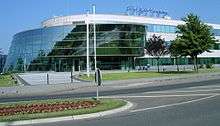Ford Motor Company
Ford Motor Company, commonly known as Ford, is an American multinational automaker that has its main headquarters in Dearborn, Michigan, a suburb of Detroit. It was founded by Henry Ford and incorporated on June 16, 1903. The company sells automobiles and commercial vehicles under the Ford brand, and most luxury cars under the Lincoln brand. Ford also owns Brazilian SUV manufacturer Troller, an 8% stake in Aston Martin of the United Kingdom and a 32% stake in Jiangling Motors.[7] It also has joint-ventures in China (Changan Ford), Taiwan (Ford Lio Ho), Thailand (AutoAlliance Thailand), Turkey (Ford Otosan), and Russia (Ford Sollers). The company is listed on the New York Stock Exchange and is controlled by the Ford family; they have minority ownership but the majority of the voting power.[8][6]
 | |
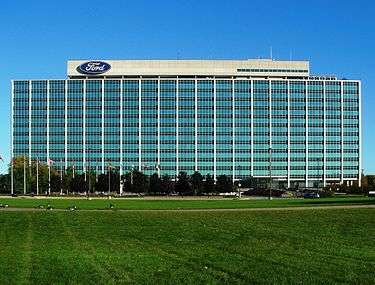 The Ford World Headquarters in Dearborn, Michigan, also known as the Glass House | |
| Public | |
| Traded as |
|
| ISIN | US3453708600 |
| Industry | Automotive |
| Founded | June 16, 1903[1] |
| Founder | Henry Ford |
| Headquarters | , U.S. |
Area served | Worldwide (Except Cuba, North Korea, Iran, Sudan and Japan) |
Key people | |
| Products |
|
Production output | |
| Services | |
| Revenue | |
| Total assets | |
| Total equity | |
| Owners |
|
Number of employees | 190,000 (December 2019)[2] |
| Divisions | |
| Subsidiaries | List
|
| Website | ford |
Ford introduced methods for large-scale manufacturing of cars and large-scale management of an industrial workforce using elaborately engineered manufacturing sequences typified by moving assembly lines; by 1914, these methods were known around the world as Fordism. Ford's former UK subsidiaries Jaguar and Land Rover, acquired in 1989 and 2000 respectively, were sold to the Indian automaker Tata Motors in March 2008. Ford owned the Swedish automaker Volvo from 1999 to 2010.[9] In 2011, Ford discontinued the Mercury brand, under which it had marketed entry-level luxury cars in the United States, Canada, Mexico, and the Middle East since 1938.
Ford is the second-largest U.S.-based automaker (behind General Motors) and the fifth-largest in the world (behind Toyota, VW, Hyundai-Kia and General Motors) based on 2015 vehicle production. At the end of 2010, Ford was the fifth largest automaker in Europe.[10] The company went public in 1956 but the Ford family, through special Class B shares, still retain 40 percent voting rights.[11][6] During the financial crisis at the beginning of the 21st century, it struggled financially, but it has since returned to profitability.[12] Ford was the eleventh-ranked overall American-based company in the 2018 Fortune 500 list, based on global revenues in 2017 of $156.7 billion.[13] In 2008, Ford produced 5.532 million automobiles[14] and employed about 213,000 employees at around 90 plants and facilities worldwide.
History
20th century


The Henry Ford Company was Henry Ford's first attempt at a car manufacturing company and was established on November 3, 1901. This became the Cadillac Motor Company on August 22, 1902, after Ford left with the rights to his name.[15] The Ford Motor Company was launched in a converted factory in 1903 with $28,000 (equivalent to $797,000 in 2019) in cash from twelve investors, most notably John and Horace Dodge (who would later found their own car company). The first president was not Ford, but local banker John S. Gray, who was chosen to assuage investors' fears that Ford would leave the new company the way he had left its predecessor. During its early years, the company produced just a few cars a day at its factory on Mack Avenue and later at its factory on Piquette Avenue in Detroit, Michigan. Groups of two or three men worked on each car, assembling it from parts made mostly by supplier companies contracting for Ford. Within a decade, the company would lead the world in the expansion and refinement of the assembly line concept, and Ford soon brought much of the part production in-house (vertical integration).
Henry Ford was 39 years old when he founded the Ford Motor Company, which would go on to become one of the world's largest and most profitable companies. It has been in continuous family control for over 100 years and is one of the largest family-controlled companies in the world.
The first gasoline-powered automobile had been created in 1885 by the German inventor Carl Benz (Benz Patent-Motorwagen). More efficient production methods were needed to make automobiles affordable for the middle class, to which Ford contributed by, for instance, introducing the first moving assembly line in 1913 at the Ford factory in Highland Park.
Between 1903 and 1908, Ford produced the Models A, B, C, F, K, N, R, and S. Hundreds or a few thousand of most of these were sold per year. In 1908, Ford introduced the mass-produced Model T, which totaled millions sold over nearly 20 years. In 1927, Ford replaced the T with the Model A, the first car with safety glass in the windshield.[16] Ford launched the first low-priced car with a V8 engine in 1932.
In an attempt to compete with General Motors' mid-priced Pontiac, Oldsmobile, and Buick, Ford created the Mercury in 1939 as a higher-priced companion car to Ford. Henry Ford purchased the Lincoln Motor Company in 1922, in order to compete with such brands as Cadillac and Packard for the luxury segment of the automobile market.
In 1929, Ford was contracted by the government of the Soviet Union to set up the Gorky Automobile Plant in Russia initially producing Ford Model A and AAs thereby playing an important role in the industrialization of that country.[17]
Ford Germany, Ford's subsidiary in Germany, produced military vehicles and other equipment for Nazi Germany's war effort. Some of Ford's operations in Germany at the time were run using forced labor.
The creation of a scientific laboratory in Dearborn, Michigan in 1951, doing unfettered basic research, led to Ford's unlikely involvement in superconductivity research. In 1964, Ford Research Labs made a key breakthrough with the invention of a superconducting quantum interference device or SQUID.[18]
Ford offered the Lifeguard safety package from 1956, which included such innovations as a standard deep-dish steering wheel, optional front, and, for the first time in a car, rear seatbelts, and an optional padded dash.[19] Ford introduced child-proof door locks into its products in 1957, and, in the same year, offered the first retractable hardtop on a mass-produced six-seater car.
In late 1955, Ford established the Continental division as a separate luxury car division. This division was responsible for the manufacture and sale of the famous Continental Mark II. At the same time, the Edsel division was created to design and market that car starting with the 1958 model year. Due to limited sales of the Continental and the Edsel disaster, Ford merged Mercury, Edsel, and Lincoln into "M-E-L," which reverted to "Lincoln-Mercury" after Edsel's November 1959 demise.
The Ford Mustang was introduced on April 17, 1964 during New York World's Fair (where Ford had a pavilion made by The Walt Disney Company.)[20][21] In 1965, Ford introduced the seat belt reminder light.
With the 1980s, Ford introduced several highly successful vehicles around the world. During the 1980s, Ford began using the advertising slogan, "Have you driven a Ford, lately?" to introduce new customers to their brand and make their vehicles appear more modern. In 1990 and 1994 respectively, Ford also acquired Jaguar Cars and Aston Martin.[22] During the mid- to late 1990s, Ford continued to sell large numbers of vehicles, in a booming American economy with a soaring stock market and low fuel prices.
With the dawn of the new century, legacy health care costs, higher fuel prices, and a faltering economy led to falling market shares, declining sales, and diminished profit margins. Most of the corporate profits came from financing consumer automobile loans through Ford Motor Credit Company.[23]
21st century
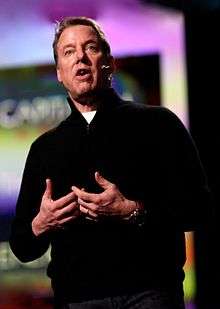
By 2005, both Ford and GM's corporate bonds had been downgraded to junk status[24] as a result of high U.S. health care costs for an aging workforce, soaring gasoline prices, eroding market share, and an overdependence on declining SUV sales. Profit margins decreased on large vehicles due to increased "incentives" (in the form of rebates or low-interest financing) to offset declining demand.[25] In the latter half of 2005, Chairman Bill Ford asked newly-appointed Ford Americas Division President Mark Fields to develop a plan to return the company to profitability. Fields previewed the Plan, named The Way Forward, at the December 7, 2005, board meeting of the company and it was unveiled to the public on January 23, 2006. "The Way Forward" included resizing the company to match market realities, dropping some unprofitable and inefficient models, consolidating production lines, closing 14 factories and cutting 30,000 jobs.[26]
Ford moved to introduce a range of new vehicles, including "Crossover SUVs" built on unibody car platforms, rather than more body-on-frame chassis. In developing the hybrid electric powertrain technologies for the Ford Escape Hybrid SUV, Ford licensed similar Toyota hybrid technologies[27] to avoid patent infringements.[28] Ford announced that it will team up with electricity supply company Southern California Edison (SCE) to examine the future of plug-in hybrids in terms of how home and vehicle energy systems will work with the electrical grid. Under the multimillion-dollar, multi-year project, Ford will convert a demonstration fleet of Ford Escape Hybrids into plug-in hybrids, and SCE will evaluate how the vehicles might interact with the home and the utility's electrical grid. Some of the vehicles will be evaluated "in typical customer settings", according to Ford.[29][30]
William Clay Ford Jr., great-grandson of Henry Ford (and better known by his nickname "Bill"), was appointed executive chairman in 1998, and also became chief executive officer of the company in 2001, with the departure of Jacques Nasser, becoming the first member of the Ford family to head the company since the retirement of his uncle, Henry Ford II, in 1982. Ford sold motorsport engineering company Cosworth to Gerald Forsythe and Kevin Kalkhoven in 2004, the start of a decrease in Ford's motorsport involvement. Upon the retirement of president and chief operations officer Jim Padilla in April 2006, Bill Ford assumed his roles as well. Five months later, in September, Ford named Alan Mulally as president and CEO, with Ford continuing as executive chairman. In December 2006, the company raised its borrowing capacity to about $25 billion, placing substantially all corporate assets as collateral.[31] Chairman Bill Ford has stated that "bankruptcy is not an option".[32] Ford and the United Auto Workers, representing approximately 46,000 hourly workers in North America, agreed to a historic contract settlement in November 2007 giving the company a substantial break in terms of its ongoing retiree health care costs and other economic issues. The agreement included the establishment of a company-funded, independently run Voluntary Employee Beneficiary Association (VEBA) trust to shift the burden of retiree health care from the company's books, thereby improving its balance sheet. This arrangement took effect on January 1, 2010. As a sign of its currently strong cash position, Ford contributed its entire current liability (estimated at approximately US$5.5 billion as of December 31, 2009) to the VEBA in cash, and also pre-paid US$500 million of its future liabilities to the fund. The agreement also gives hourly workers the job security they were seeking by having the company commit to substantial investments in most of its factories.
The automaker reported the largest annual loss in company history in 2006 of $12.7 billion,[33] and estimated that it would not return to profitability until 2009.[34] However, Ford surprised Wall Street in the second quarter of 2007 by posting a $750 million profit. Despite the gains, the company finished the year with a $2.7 billion loss, largely attributed to finance restructuring at Volvo.[35]
On June 2, 2008, Ford sold its Jaguar and Land Rover operations to Tata Motors for $2.3 billion.[36][37]
During congressional hearings held in November 2008 at Washington D.C., and in a show of support, Ford's Alan Mulally stated that "We at Ford are hopeful that we have enough liquidity. But we also must prepare ourselves for the prospect of further deteriorating economic conditions". Mulally went on to state that "The collapse of one of our competitors would have a severe impact on Ford" and that Ford Motor Company supports both Chrysler and General Motors in their search for government bridge loans in the face of conditions caused by the 2008 financial crisis.[38][39] Together, the three companies presented action plans for the sustainability of the industry. Mulally stated that "In addition to our plan, we are also here today to request support for the industry. In the near-term, Ford does not require access to a government bridge loan. However, we request a credit line of $9 billion as a critical backstop or safeguard against worsening conditions as we drive transformational change in our company"[40] GM and Chrysler received government loans and financing through T.A.R.P. legislation funding provisions.[41]
On December 19, the cost of credit default swaps to insure the debt of Ford was 68 percent the sum insured for five years in addition to annual payments of 5 percent. That meant $6.8 million paid upfront to insure $10 million in debt, in addition to payments of $500,000 per year.[42] In January 2009, Ford reported a $14.6 billion loss in the preceding year, a record for the company. The company retained sufficient liquidity to fund its operations. Through April 2009, Ford's strategy of debt for equity exchanges erased $9.9 billion in liabilities (28% of its total) in order to leverage its cash position.[43] These actions yielded Ford a $2.7 billion profit in fiscal year 2009, the company's first full-year profit in four years.[44] In 2012, Ford's corporate bonds were upgraded from junk to investment grade again, citing sustainable, lasting improvements.[45]
On October 29, 2012, Ford announced the sale of its climate control components business, its last remaining automotive components operation, to Detroit Thermal Systems LLC for an undisclosed price.[46]
On November 1, 2012, Ford announced that CEO Alan Mulally will stay with the company until 2014. Ford also named Mark Fields, the president of operations in Americas, as its new chief operating officer[47] Ford's CEO Mulally was paid a compensation of over $174 million in his previous seven years at Ford since 2006. The generous amount has been a sore point for some workers of the company.[48]
In April 2016, Ford announced a plan to modernize its Dearborn engineering and headquarters campuses through a ten-year building project. The end result would see the number of Ford employees working in these areas doubling, to 24,000. During construction, some 2000 of the employees were relocated out of the campus to a temporary location in a disused section of the local shopping mall.[49] Facilities would also be altered to allow ride-sharing and electric and self-driving vehicles.[50] Estimates of the construction cost were $1.2 billion.[51]
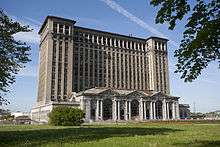
On January 3, 2017, Ford CEO Mark Fields announced that in a "vote of confidence" because of the pro-business climate being fostered in part by President-elect Donald Trump, Ford has canceled plans to invest $1.6 billion in a new plant in Mexico to manufacture the Ford Focus. The Ford Focus will now be manufactured in the existing plant in Mexico. Instead, Fields announced that Ford will be investing $700 million in Michigan, which it plans to use to create 700 new jobs.[52] Also in 2017, Ford began development of a new mixed-use urban campus in the Corktown neighborhood of Detroit, with its purchase, renovation, and occupation of The Factory at Michigan and Rosa Parks. The new site was expected to have a major focus on the development of autonomous vehicle and electric vehicle technology.[53] Ford later began buying up other parcels of land in Corktown including a very high-profile purchase of Michigan Central Station which is planned to become the hub of their Corktown campus, and the adjacent Roosevelt Warehouse.[54] Ford expects to move 2,500 of its employees, roughly 5 percent of its southeast Michigan workforce, to the campus with space for an additional 2,500 entrepreneurs, technology companies and partners.[55] Bill Ford envisioned the first-floor concourse of the train station to be a public gathering place with retail outlets and restaurants.[56]
In February 2017, Ford Motor Co. acquired majority ownership of Argo AI, a self-driving car startup.[57]
In May 2017, Ford announced cuts to its global workforce amid efforts to address the company's declining share price and to improve profits. The company is targeting $3 billion in cost reduction and a nearly 10% reduction in the salaried workforce in Asia and North America to enhance earnings in 2018.[58][59] Jim Hackett was announced to replace Mark Fields as CEO of Ford Motor. Mr. Hackett most recently oversaw the formation of Ford Smart Mobility, a unit responsible for experimenting with car-sharing programs, self-driving ventures and other programs aimed at helping Ford better compete with Uber, Alphabet Inc. and other tech giants looking to edge in on the auto industry.[60][61]
On April 25, 2018, Ford announced that it will discontinue passenger cars in the North American market in the next four years, except for the Mustang, due to declining demand and profitability.[62] The Focus Active, a crossover SUV based on the newly-unveiled fourth-generation Focus, was also intended to be marketed in the United States. Due to the vehicle being manufactured in China, Ford later announced that it would not release the Focus Active in the United States, due to tariffs imposed by the Trump administration on Chinese exports.[63][64]
In March 2020, the Detroit United Auto Workers union announced that after discussion with the leaders of General Motors, Ford, and Fiat Chrysler Automobiles, the carmakers would partially shut down factories on a "rotating" basis to mitigate the COVID-19 pandemic.[65] On March 24, representatives of Ford announced that production in the US, Canada, and Mexico will not resume on March 30 as it was originally planned amid the further coronavirus pandemic spread.[66] In the first quarter of 2020, Ford's sales dropped by 15%, entailing the loss of $2 billion.[67]
Logo evolution
 1903
1903 1907
1907 1909
1909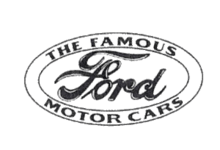 1911
1911 1912
1912 1912 variant
1912 variant 1927
1927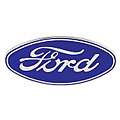 1957
1957 1976
1976 2003
2003 2017–
2017–
Corporate affairs
Executive management
Members of the Ford board as of October 2018 are: Stephen Butler, Kimberly Casiano, Anthony F. Earley, Jr., Edsel Ford II, William Clay Ford Jr. (executive chairman), Jim Hackett (president and CEO), William W. Helman IV, William E. Kennard, John C. Lechleiter, Ellen Marram, John L. Thornton, John Veihmeyer, Lynn Vojvodich, and John S. Weinberg.[68]
In August 2020, it was revealed that Jim Farley is to become the new chief executive officer of the company; he previously served as Ford's chief operating officer. The company's former CEO, Hackett, will stay in the company as an advisor until the second quarter of 2021.[69]
Ford Motor Company Fund
The Ford Motor Company Fund (also known as Ford Fund, not affiliated with the Ford Foundation), based in Dearborn, Michigan, is the philanthropic arm of the Ford Motor Company.[70] Established in 1949[71] by Henry Ford II, Ford Fund is a nonprofit corporate foundation[72] financed by contributions from Ford Motor Company. In 2017, Ford Fund contributed $63 million[73] to various causes[70] with a focus on education, driving safely and community building.
The Ford Driving Skills for Life program is a driver safety program aimed at teens that were developed together with the Governors Highway Safety Association and safety experts.[74] The Ford Volunteer Corps allows Ford employees and retirees to sign up for volunteering work on local projects in more than 40 countries.[75] The Ford Fund invests $18 million annually in education in the United States and around the world, but accepts applications only from nonprofit organizations registered in the U.S.[76] Education programs and scholarships include Alan Mulally Engineering Scholarship, Ford Blue Oval Scholars Program, Ford College Community Challenge (Ford C3), Ford Driving Dreams Tour, Ford Fund/Detroit Free Press Journalism Scholarship, Ford Next Generation Learning (Ford NGL), Grants to Individuals Program, HBCU Community Challenge, Smithsonian Latino Center Young Ambassadors Program, and William Clay Ford Automotive Design Scholarship.
Operations
Ford has had manufacturing operations worldwide, including in the United States, Canada, Mexico, China, India, the United Kingdom, Germany, Turkey, Brazil, Argentina, Australia, and South Africa. Ford also has a cooperative agreement with Russian automaker GAZ.
North America

In May 2010, Ford reported that its sales increased 23% for the month, and that 37% of its sales came from fleet sales.[77] In June 2010, Sales to individual customers at dealerships increased 13% while fleet sales rose by 32%.[78] In the first seven months of 2010, fleet sales of Ford for the same period rose 35% to 386,000 units while retail sales increase 19%.[79] Fleet sales account for 39 percent of Chrysler's sales and 31 percent for GM's.[79]
Europe
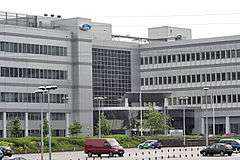
At first, Ford in Germany and Ford in Britain built different models from one another until 1965, when the Ford Transit and later the Ford Escort and the Ford Capri became common to both companies. In 1970, the Ford Taunus and the Ford Cortina came into production with a common base construction, both models being produced in left hand drive and right hand drive. Later on, the models became identical and the respective models right and left hand drive exclusively. Rationalisation of model ranges meant that production of many models in the UK switched to elsewhere in Europe, including Belgium and Spain as well as Germany. The Ford Sierra replaced the Taunus and Cortina in 1982, drawing criticism for its radical aerodynamic styling, which was soon given nicknames, the "Jellymould" and "The Salesman's Spaceship."
In February 2002, Ford ended car production in the UK. It was the first time in 90 years that Ford cars had not been made in Britain, although production of the Transit van continued at the company's Southampton facility until mid-2013, engines at Bridgend and Dagenham, and transmissions at Halewood. Development of European Ford is broadly split between Dunton in Essex (powertrain, Fiesta/Ka, and commercial vehicles) and Cologne (body, chassis, electrical, Focus, Mondeo) in Germany. Ford also produced the Thames range of commercial vehicles, although the use of this brand name was discontinued circa 1965. Elsewhere in continental Europe, Ford assembles the Mondeo, Galaxy, S-Max[81] and Kuga[82] in Valencia (Spain), Fiesta in Cologne (Germany), Focus in Saarlouis (Germany), Ecosport[83] and Puma[84] in Craiova (Romania).
Ford also owns a joint-venture production plant in Turkey. Ford Otosan, established in the 1970s, manufactures the Transit Connect compact panel van as well as the "Jumbo" and long-wheelbase versions of the full-size Transit. This new production facility was set up near Kocaeli in 2002, and its opening marked the end of Transit assembly in Genk.
Another joint venture plant near Setúbal in Portugal, set up in collaboration with Volkswagen, formerly assembled the Galaxy people-carrier as well as its sister ships, the VW Sharan and SEAT Alhambra. With the introduction of the third generation of the Galaxy, Ford has moved the production of the people-carrier to the Genk plant, with Volkswagen taking over sole ownership of the Setúbal facility.
In 2008, Ford acquired a majority stake in Automobile Craiova, Romania. Starting 2009, the Ford Transit Connect was Ford's first model produced in Craiova, followed, in 2012, by low-capacity car engines and a new small class car, the B-Max.[85]
Its 1959 Anglia two-door saloon was one of the most quirky-looking small family cars in Europe at the time of its launch, but buyers soon became accustomed to its looks and it was hugely popular with British buyers in particular. It was still selling well when replaced by the more practical Escort in 1967.
The third incarnation of the Ford Escort was launched in 1980 and marked the company's move from rear-wheel drive saloons to front-wheel drive hatchbacks in the small family car sector.
The fourth generation Escort was produced from 1990 until 2000, although its successor – the Focus – had been on sale since 1998. On its launch, the Focus was arguably the most dramatic-looking and fine-handling small family cars on sale and sold in huge volumes right up to the launch of the next generation Focus at the end of 2004.
The 1982 Ford Sierra – replacement for the long-running and massively popular Cortina and Taunus models – was a style-setter at the time of its launch. Its ultramodern aerodynamic design was a world away from a boxy, sharp-edged Cortina, and it was massively popular just about everywhere it was sold. A series of updates kept it looking relatively fresh until it was replaced by the front-wheel drive Mondeo at the start of 1993.
The rise in popularity of small cars during the 1970s saw Ford enter the mini-car market in 1976 with its Fiesta hatchback. Most of its production was concentrated at Valencia in Spain, and the Fiesta sold in huge figures from the very start. An update in 1983 and the launch of an all-new model in 1989 strengthened its position in the small car market.
On October 24, 2012, Ford announced that it would be closing its Genk assembly plant in eastern Belgium by the end of 2014.[86]
In 2015, Ford announced that it took control of Ford Sollers, Ford's joint venture with Russian company Sollers.[87][88]
In September 2018, at the IAA Commercial Vehicles show in Hannover, Germany, Ford introduced an electric tractor trailer concept vehicle dubbed the F-Vision, which would have Level 4 autonomous driving capability.[89]
East and Southeast Asia
Ford formed its first passenger-vehicle joint venture in China in 2001, six years behind GM and more than a decade after VW. It has spent as of 2013 $4.9 billion to expand its lineup and double production capacity in China to 600,000 vehicles. This includes Ford's largest-ever factory complex in the southwestern city of Chongqing. Ford had 2.5% of the Chinese market in 2013, while VW controlled 14.5% and GM had 15.6%, according to consultant LMC Automotive. GM outsells Ford in China by more than six-to-one.[90] Ford's presence in Asia has traditionally been much smaller, confined to Malaysia, Singapore, Hong Kong, the Philippines, and Taiwan, where Ford has had a joint venture with Lio Ho since the 1970s. Ford began assembly of cars in Thailand in 1960, but withdrew from the country in 1976, and did not return until 1995 when it formed a joint venture with Mazda called Auto Alliance.[91] Now based in the Bo-win Sub District of the Sriracha District in Chonburi, the factory still produces passenger automobiles. The factory built in 1941 in Singapore was shortly taken over by the Japanese during the war and was the site of a surrender of the British to the Japanese, at the factory site which is now a national monument in Singapore. On April 30, 2013, Ford Motor Co. launched their car and truck line in Myanmar. Previously, heavy importation taxes had stifled imported car purchases in Myanmar, but due to currency reform, lifting of previous import restrictions, and the abolishment of shadow currency, Myanmar's car market had grown in demand.[92]
South Korea
In 1967, Ford partnered with the South Korean company Hyundai, and at the new factory in Ulsan, South Korea, built the European Ford Cortina until 1974 when Hyundai introduced their all-new Hyundai Pony in 1975. Ford then developed a relationship with Korea's oldest car manufacturer Kia which built vehicles co-engineered with Mazda, later selling the Ford Festiva from 1988–1993, and the Ford Aspire from 1994–1997 for export to the United States. With the acquisition of a stake in Japanese manufacturer Mazda in 1979, Ford began selling Mazda's Familia and Capella as the Ford Laser and Telstar throughout the region, replacing the European-sourced Escort and Cortina. From 1989 to 1996, Kia imported the Mercury Sable from Ford in the U.S., and sold them in South Korea as the Kia Sable. Though the Sable was branded and marketed as a Kia, it retained the Mercury badges and emblem. Ford lost their Kia interest to Hyundai in 1998 during the Asian financial crisis. Kia had declared bankruptcy in 1997; in 1998, Hyundai Motor Company acquired 51% of the company, outbidding Ford which had owned an interest in Kia Motors since 1986.[93] After subsequent divestments,[94] Hyundai Motor Company owns less than 50% of the company but remains Kia's largest stakeholder.
As of 2020, Ford sells the Explorer, Mondeo, and Mustang[95], as well as the Lincoln Aviator, Continental, Corsair, MKZ, and Nautilus in South Korea.[96]
South and West Asia
Ford India began production in 1998 at Chennai, Tamil Nadu, with its Ford Escort model, which was later replaced by the locally produced Ford Ikon in 2001. It has since added the Fusion, Fiesta, Mondeo and Endeavour models to its product line.
On March 9, 2010, Ford launched its first made-for-India compact car. Starting at ₹349,900, the Figo was Ford's first car designed and priced for the mass Indian market.[97] On July 28, 2011, Ford India signed a memorandum of understanding (MoU) with the State of Gujarat for the construction of an assembly and engine plant in Sanand and planned to invest approximately US$1 billion on a 460-acre site.[98] In 2019, the company and Mahindra & Mahindra formed a joint venture to develop, market and distribute Ford-branded vehicles in India.[99]
Ford's market presence in the Middle East has traditionally been small, partly due to previous Arab boycotts of companies dealing with Israel. Ford and Lincoln vehicles are currently marketed in ten countries in the region.[100] Saudi Arabia, Kuwait, and the United Arab Emirates are the biggest markets. Ford also established itself in Egypt in 1926 but faced an uphill battle during the 1950s due to the hostile nationalist business environment.[101] Ford's distributor in Saudi Arabia announced in February 2003 that it had sold 100,000 Ford and Lincoln vehicles since commencing sales in November 1986. Half of the Ford and Lincoln vehicles sold in that country were Ford Crown Victorias.[102] In 2004, Ford sold 30,000 units in the region, falling far short of General Motors' 88,852 units and Nissan Motors' 75,000 units.
South America
In South America, Ford's primary operations are in Brazil, Argentina, and Ford Andina[103] (Colombia, Ecuador, and Venezuela). Ford employs over 18,000 people and operates seven assembly or other plants in the region.[104] In 1987, Ford Brasil and Ford Motor Argentina merged their operations with the Brazilian and Argentine operations of Volkswagen Group, forming a new joint-venture company called Autolatina with a shared model range.[105] Autolatina was dissolved in 1995.[105]
Africa
In Africa, Ford's market presence has traditionally been strongest in South Africa and neighbouring countries, with only trucks being sold elsewhere on the continent. Ford in South Africa began by importing kits from Canada to be assembled at its Port Elizabeth facility. Later Ford sourced its models from the UK and Australia, with local versions of the Ford Cortina including the XR6, with a 3.0 V6 engine, and a Cortina-based 'bakkie' or pick-up, which was exported to the UK. In the mid-1980s, Ford merged with a rival company, owned by Anglo American, to form the South African Motor Corporation (Samcor).[106]
Following international condemnation of apartheid, Ford divested from South Africa in 1988, and sold its stake in Samcor, although it licensed the use of its brand name to the company.[107] Samcor began to assemble Mazdas as well, which affected its product line-up and saw the European Fords like the Escort and Sierra replaced by the Mazda-based Laser[108] and Telstar.[109] Ford bought a 45 per cent stake in Samcor following the demise of apartheid in 1994, and this later became, once again, a wholly owned subsidiary, the Ford Motor Company of Southern Africa. Ford now sells a local sedan version of the Fiesta (also built in India and Mexico), and the Focus. The Falcon model from Australia was also sold in South Africa but was dropped in 2003 while the Mondeo, after briefly being assembled locally, was dropped in 2005. The Mondeo was later reintroduced in 2015, badged as the Fusion but was dropped in 2017.[110]
Research
Ford Research and Innovation Center is the name of the technology research facilities of Ford Motor Company in
- Dearborn, Michigan
- Palo Alto, California
- Aachen, Germany
- Nanjing, China
The Ford Research and Innovation Center in Palo Alto was first opened in 2012, and in January 2015, announced plans to significantly expand its operations.[111][112][113][114]
Former operations
East and Southeast Asia
Ford decided to shut down their entire operations in Indonesia, including their dealer network by second half of 2016.[115][116]
Ford of Japan
Ford established a manufacturing facility in the port city of Yokohama in February 1925, where Model T vehicles were assembled using imported knock-down kits.[117] The factory subsequently produced 10,000 Model A's up to 1936. Production ceased in 1940 as a result of political tensions between Japan and the United States.
After World War II, Ford did not have a presence in Japan, as the Ford facility was appropriated by the Japanese Government until 1958 when property was returned as a possession of the Ford Motor Company and became a research and development location for Ford partner Mazda. In 1979, Ford acquired a 24.5% ownership stake in Mazda, and in 1982, Ford and Mazda jointly established a sales channel to sell Ford products in Japan, including vehicles manufactured in North America, at a dealership called Autorama (Japanese). The Autorama sales channel was renamed Ford Sales of Japan in 1997.[118]
Vehicles sold at Autorama locations were the North American assembled Ford Explorer, Probe (1989–1998), Mustang, Taurus (1989–1997), Thunderbird (1990–1993), Lincoln Continental, and Lincoln LS. Ford products manufactured in Europe that were sold in Japan were the Ford Mondeo, Ka, Focus, Focus C-MAX, Fiesta, and the Galaxy. Mazda manufactured Ford vehicles in Japan and sold them as Fords at the Autorama locations. They were the Ford Telstar (Mazda Capella), Laser, Festiva, Festiva Mini Wagon, Ixion (Mazda Premacy), Freda (Mazda Bongo Friendee), Spectron (Mazda Bongo), and commercial trucks J80 and the J100 (Mazda Bongo truck).
Ford increased its shareholding in Mazda to 33.4% in 1996, but as of July 2016, it is listed at 11%.[119] Ford did sell a small range of vehicles in Japan; as of October 2010, the Ford Mustang, Escape, Explorer (and Explorer truck), Ford Kuga, Lincoln Navigator, Lincoln MKX, and more recently, the Ford Ecosport were available in Japan. As of February 2016, Ford no longer maintains a regional office in Minato, Tokyo, Japan, and sales of new cars in Japan have ended.[120][121]
Oceania
_XR6_Turbo_sedan_(23382738252).jpg)
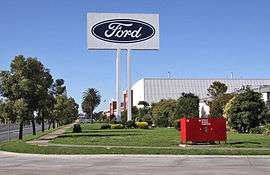
In Australia and New Zealand, the popular Ford Falcon (1960–2016) had long been considered the average family car and is considerably larger than the Mondeo, Ford's largest car sold in Europe. Between 1960 and 1972, the Falcon was based on a U.S. model of the same name, but since then has been entirely designed and manufactured in Australia until 2016, occasionally being manufactured in New Zealand. Like its General Motors rival, the Holden Commodore, the Falcon used a rear wheel drive layout. High-performance variants of the Falcon running locally built engines produce up to 362 hp (270 kW). A ute (short for "utility", known in the US as pickup truck) version is also available with the same range of drivetrains. In addition, Ford Australia sells highly tuned limited-production Falcon sedans and utes through its performance car division, Ford Performance Vehicles until it closed in 2014.
In Australia, the Commodore and Falcon had traditionally outsold all other cars and comprise over 20% of the new car market. In New Zealand, Ford was second in market share in the first eight months of 2006 with 14.4%.[122] More recently, Ford has axed its Falcon-based LWB variant of its lineup– the Fairlane and LTD ranges. Ford discontinued the Fairlane in 2007 and LTD in 2008. Ford had announced that their Geelong engine manufacturing plant would be shut down between 2013 and 2016. They had earlier announced local manufacturing of the Focus small car starting from 2011, but instead decided to import the model from Ford's plant in Thailand.[123]
In Australia, the Laser was one of Ford Australia's most successful models and was manufactured in Ford's Homebush plant from 1981 until the plant's closure in September 1994. It outsold the Mazda 323, despite being almost identical to it because the Laser was manufactured in Australia and Ford was perceived as a local brand.[124] According to research carried out by Ford Australia in 1984, a third of Laser buyers were unaware that the Ford model was based on the Mazda 323.[125]
In New Zealand, the Ford Laser and Telstar were assembled alongside the Mazda 323 and 626 until 1997, at the Vehicle Assemblers of New Zealand (VANZ) plant in Wiri, Auckland.[126] The Sierra wagon was also assembled in New Zealand, owing to the popularity of station wagons in that market.[127]
The scheduled closure of Ford's Australian manufacturing base in 2016 was confirmed on May 23, 2013. Headquartered in the Victorian suburb of Broadmeadows, the company had registered losses worth AU$600 million over the five years prior to the announcement. It was noted that the corporate fleet and government sales that account for two-thirds of large, local car sales in Australia are insufficient to keep Ford's products profitable and viable in Australia. The decision will affect 1200 Ford workers—over 600 employees in Geelong and more than 500 in Broadmeadows—who will lose their jobs by October 2016. The closure of Fords plants in Norlane Geelong and Broadmeadows Melbourne occurred on October 7, 2016.[128]
Products and services
Automobiles
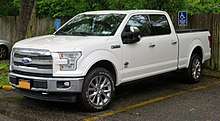
Ford Motor Company sells a broad range of automobiles under the Ford marque worldwide, and an additional range of luxury automobiles under the Lincoln marque in the United States. The company has sold vehicles under a number of other marques during its history. The Mercury brand was introduced by Ford in 1939, continuing in production until 2011 when poor sales led to its discontinuation.[129] In 1958, Ford introduced the Edsel brand, but poor sales led to its discontinuation in 1960. In 1985, the Merkur brand was introduced in the United States to market products produced by Ford of Europe; it was discontinued in 1989.
Ford acquired the British sports car maker Aston Martin in 1989, later selling it on March 12, 2007,[130] although retaining an 8% stake.[131][132] Ford purchased Volvo Cars of Sweden in 1999,[133] selling it to Zhejiang Geely Holding Group in 2010. In November 2008, it reduced its 33.4% controlling interest in Mazda of Japan to a 13.4% non-controlling interest.[134]
On November 18, 2010, Ford reduced their stake further to just 3%, citing the reduction of ownership would allow greater flexibility to pursue growth in emerging markets. Ford and Mazda remain strategic partners through exchanges of technological information and joint ventures, including an American joint venture plant in Flat Rock, Michigan called Auto Alliance.[135] Ford sold the United Kingdom-based Jaguar and Land Rover companies and brands to Tata Motors of India in March 2008. In 2015, Ford sold its remaining 3% stake in Mazda.[136]
On April 25, 2018, Ford announced that it planned to phase out all but one of its North American automobile models (the Mustang will be the sole surviving model) to focus primarily on trucks and SUVs. Ford had also planned to introduce an "Active" crossover version of the next-generation Focus, but canceled those plans due to tariff issues between the United States and China.[137]
Current marques
| Marque | Country of origin | Years used/owned | Markets |
|---|---|---|---|
| Ford | United States | 1903–present | Global |
| Lincoln | United States | 1922–present | North America, Middle East, China, South Korea |
| Troller | Brazil | 2007–present | Brazil |
Former marques
| Marque | Country of origin | Years used/owned | Markets |
|---|---|---|---|
| Mercury | United States | 1939–2011 | North America, Middle East |
| Continental | United States | 1956–1960 | North America |
| Edsel | United States | 1957–1960 | North America |
| Merkur | United States | 1985–1989 | North America |
| Jaguar | United Kingdom | 1989–2008 | Global |
| Aston Martin | United Kingdom | 1989–2007 | Global |
| Volvo | Sweden | 1999–2010 | Global |
| Land Rover | United Kingdom | 2000–2008 | Global |
| Mazda | Japan | 1974–2015 | Global |
| FPV | Australia | 2002–2014 | Australia |
Trucks
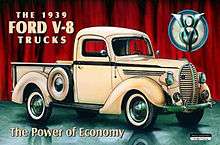
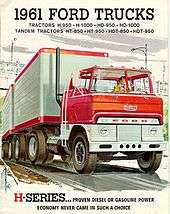
Ford has produced trucks since 1908, beginning with the Ford Model TT, followed by the Model AA, and the Model BB. Countries where Ford commercial vehicles are or were formerly produced include Argentina, Australia, Brazil, Canada (also badged as Mercury), France, Germany, India, Netherlands, Philippines, Spain (badged Ebro too), Turkey, UK (badged also Fordson and Thames), and the United States.
From the 1940s to late 1970s, Ford's Ford F-Series were used as the base for light trucks for the North American market.
Most of these ventures are now extinct. The European one that lasted longest was the lorries arm of Ford of Britain, which became part of the Iveco group in 1986. Ford had a minority share in the new company and Iveco took over sales and production of the Ford Cargo range.[138] Ford's last significant European truck models were the Transcontinental and the Cargo. At the end of 1996, Ford sold the rights to its heavy trucks division to the Freightliner Trucks division of Daimler AG, with Ford producing the Cargo, Louisville, and Aeromax, through the 1998 model year. During the 1998 model year, Freightliner began production of its own versions of Ford-developed trucks in St. Thomas, Ontario, launching the Sterling truck brand.[139][140] Slotted between Freightliner and Western Star, Sterling trucks were produced through 2009.
Line of heavy trucks made by Ford for the North American market:
- Ford F-Series
- "Super Duty/Extra Heavy Duty (1958-1962)
- "Big Job" (1951-1957)
- Ford N-Series (1963-1969)
- Ford L-Series trucks (1970-1998)
- aka Ford "Louisville Line"
- Ford Aeromax (1988-1998)
- Ford Louisville (1996-1998)
- Sterling (1998-2009)
- Ford C-Series (1957-1990)
- Ford Cargo/CF-Series (1986-1997)
- Ford H-Series (1961-1966)
- aka "Two-story Falcon"
- Ford W-Series (1966-1977)
- Ford CL-Series (1978-1995)
For 1999, Ford briefly withdrew from production of medium-duty trucks. For the 2001 model year, the company entered into a joint venture with Navistar International (the supplier of diesel engines for 1-ton F-Series trucks), named Blue Diamond Truck Company LLC.[141] As part of the joint venture, sharing a common truck chassis, the two companies would produce medium-duty (Class 6-7) trucks in a Navistar facility in Mexico, with each manufacturer supplying its own powertrain and bodywork, with the Ford F-650/F-750 Super Duty and International 4000/DuraStar sharing an assembly line. In 2006, the joint venture debuted the Ford LCF/International CityStar.[142] Using a modified F-Series chassis adopted to fit a Mazda Titan cab, the LCF was a low-cab forward truck that was sold through 2009.[143]
In Europe, Ford manufactures the Ford Transit jumbo van which is classed as a Large Goods Vehicle and has a payload of up to 2,265 kg, there are options of a panel van, pickup or chassis cab. The Ford Transit is also available as a light van called the Ford Transit Connect and the Ford Ranger pickup is available.[144]
Buses

Ford manufactured complete buses in the company's early history, but today the role of the company has changed to that of a second stage manufacturer. In North America, the E-Series is still used as a chassis for small school buses and the F-650 is used in commercial bus markets. In the 1980s and 1990s, the medium-duty B700 was a popular chassis used by school bus body manufacturers including Thomas Built, Ward, and Blue Bird, but Ford lost its market share due to industry contraction and agreements between body manufacturers. Older bus models included:
Prior to 1936, Ford buses were based on truck bodies:
- Model B – 1930s
- Model T – 1920s
- F-105 school bus
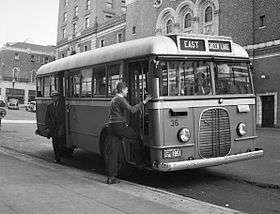
In 1936, Ford introduced the Ford Transit Bus, a series of small transit buses with bodies built by a second party. Originally a front-engine design, it was modified to a rear-engine design in 1939. About 1,000 to 1,200 of the original design were built, and around 12,500 of the rear-engine design, which was in production until 1947[145] (rebranded as the Universal Bus in 1946).
Rear-engine Transit Bus chassis model numbers:[146]
- 09-B/19-B City transit bus – 1939–1941
- 19-B/29-B City transit bus – 1941–1942
- 49-B/79-B City transit bus – 1944–1947
- 69-B City transit bus – 1946–1947
- 29-B City transit bus – 1946–1947
- 72-T transit bus – 1944–1945
After 1946 the Transit City bus was sold as the Universal Bus with the roof changed from fabric/wood to all-metal:
- 79-B Universal transit bus – 1946–1947
Succeeding the Ford Transit Bus was the Ford 8M buses:
- 8MB transit bus – with Wayne Works 1948–?
Following World War II and from the 1950s onwards, Ford lost out to General Motors.[146] This led to the end of transit buses for Ford in North America.
- B500 or B-series – 1950–1990s based on Ford F-series truck chassis used by school bus body manufacturers
In Europe, Ford manufactures the Ford Transit Minibus which is classed in Europe as a Passenger Carrying Vehicle and there are options of 12-, 15-, or 17-seaters.[147] In the past, European models included:
- EM
- N-138
- D series buses (Australia)
Tractors
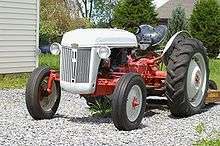
The "Henry Ford and Son Company" began making Fordson tractors in Henry's hometown of Springwells (later part of Dearborn), Michigan from 1907 to 1928, from 1919 to 1932, at Cork, Ireland, and 1933–1964 at Dagenham, England, later transferred to Basildon. They were also produced in Leningrad beginning in 1924.
Ford reentered the tractor market in 1939 with the Ford N-series tractors. The Ford N8, introduced in 1947, became the most popular tractor of all time in North America. Production of the N line of models ended in 1952.
The Ford NAA tractor was introduced as an entirely new model in 1953. It was a replacement for the Ford N-Series tractors. Larger than the 8N, with a four-cylinder engine, and streamlined styling.
In 1986, Ford expanded its tractor business when it purchased the Sperry-New Holland skid-steer loader and hay baler, hay tools and implement company from Sperry Corporation and formed Ford-New Holland which bought out Versatile tractors in 1988. This company was bought by Fiat in 1993 and the name changed from Ford New Holland to New Holland. New Holland is now part of CNH Global.
Financial services
Ford offers automotive finance through Ford Motor Credit Company.
Automotive components
Ford's FoMoCo parts division sells aftermarket parts under the Motorcraft brand name. It has spun off its parts division under the name Visteon.
Motorsport
Along with Shelby and Chevrolet, Ford is one of only three American constructors to win titles on the international scene at the FIA World Championships. As a constructor, Ford won the World Sportscar Championship three times in 1966, 1967, and 1968, and the World Rally Championship three times in 1979, 2006 and 2007.
Open-wheel car racing
IndyCar
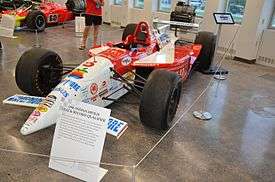
IndyCars with Ford engines first competed in 1935 using a production-based Ford V8 in the Miller-Ford racer.[148][149] A pushrod Ford V8 raced with Lotus in 1963, and Ford's first Indy win was in 1965 with a DOHC V8.[150][151] Ford motors, including the Ford-sponsored DFX engine developed by Cosworth, have won the Indianapolis 500 eighteen times.[152] On May 12, 1996, Arie Luyendyk, while driving an IndyCar powered by a Ford Cosworth XB engine, broke the Indianapolis 500 records for fastest qualification lap (237.498 mph (382.216 km/h)) and fastest qualification four-lap average (236.986 mph (381.392 km/h)).[153][154] These speed records still stand as of 2018.[155]
Formula Ford
Formula Ford, conceived in the UK in 1966, is an entry-level type of formula racing with wingless single-seater cars. Many of today's formula racing drivers started their car racing careers in this category.
Formula One
Ford was heavily involved in Formula One for many years and supplied engines to a large number of teams from 1967 until 2004. These engines were designed and manufactured by Cosworth, the racing division that was owned by Ford from 1998 to 2004. Ford-badged engines won 176 Grands Prix between 1967 and 2003 for teams such as Team Lotus and McLaren. Ford entered Formula One as a constructor in 2000 under the Jaguar Racing name, after buying the Stewart Grand Prix team which had been its primary 'works' team in the series since 1997. Jaguar achieved little success in Formula One, and after a turbulent five seasons, Ford withdrew from the category after the 2004 season, selling both Jaguar Racing (which became Red Bull Racing) and Cosworth (to Gerald Forsythe and Kevin Kalkhoven).[156]
Stock car racing
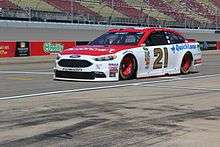
Ford is one of three manufacturers in NASCAR's three major series: the Cup Series, Xfinity Series, and Truck Series. Major teams include Roush Fenway Racing, Team Penske, Stewart-Haas Racing, and Wood Brothers Racing. Ford is represented by the Mustang GT in the Cup Series, and the Xfinity Series and by the F-150 in the Truck Series. Some of the most successful NASCAR Fords were the aerodynamic fastback Ford Torino, Ford Torino Talladega, Mercury Cyclone Spoiler II, and Mercury Montegos, and the aero-era Ford Thunderbirds. The Ford nameplate has won eight manufacturer's championships in Sprint Cup while Mercury has won one. In the Sprint Cup Series, Ford earned its 1,000th victory in the 2013 Quicken Loans 400.[157] The Ford Fusion is also used in the ARCA Racing Series. Ford had last won a drivers' championship in the Cup Series with Joey Logano in 2018.
Rally
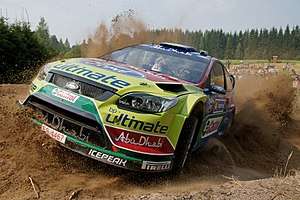
Ford has a long history in rallying and has been active in the World Rally Championship since the beginning of the world championship, the 1973 season. Ford took the 1979 manufacturers' title with Hannu Mikkola, Björn Waldegård, and Ari Vatanen driving the Ford Escort RS1800. In the Group B era, Ford achieved success with Ford RS200. Since the 1999 season, Ford has used various versions of the Ford Focus WRC to much success. In the 2006 season, BP-Ford World Rally Team secured Ford its second manufacturers' title, with the Focus RS WRC 06 built by M-Sport and driven by "Flying Finns" Marcus Grönholm and Mikko Hirvonen.[158] Continuing with Grönholm and Hirvonen, Ford successfully defended the manufacturers' world championship in the 2007 season. Ford is the only manufacturer to score in the points for 92 consecutive races; since the 2002 season opener Monte Carlo Rally.[159]
Rallycross
Ford has competed in rallycross with its Ford Fiesta and Ford Focus. Tanner Foust won the Global RallyCross Championship in 2011 and 2012 and was runner-up in the FIA European Rallycross Championship in 2011 and 2012. Toomas Heikkinen won the Global RallyCross Championship title in 2013 and Joni Wiman won it in 2014. Other notable Ford drivers include Marcus Grönholm, Ken Block, and Brian Deegan.
Sports cars
Ford sports cars have been visible in the world of sports car racing since 1964. Most notably the GT40 won the 24 Hours of Le Mans four times in the 1960s and is the only American car to ever win overall at this prestigious event. Ford also won the 1968 International Championship for Makes with the GT40. Swiss team Matech GT Racing, in collaboration with Ford Racing, opened a new chapter with the Ford GT, winning the Teams title in the 2008 FIA GT3 European Championship.
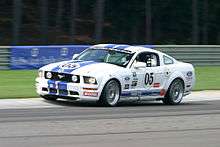
The Ford Mustang has arguably been Ford's most successful sports car. Jerry Titus won the 1965 SCCA Pro B National Championship with a Mustang and the model went on to earn Ford the SCCA Trans-Am Championship title in both 1966 and 1967. Ford won the Trans-Am Championship again in 1970 with Parnelli Jones and George Follmer driving Boss 302 Mustangs for Bud Moore Engineering. Ford took the 1985 and 1986 IMSA GTO Championship with Mustangs driven by John Jones and Scott Pruett before returning to Trans-Am glory with a championship in 1989 with Dorsey Schroeder. Ford dominated Trans-Am in the 1990s with Tommy Kendall winning championships in 1993, 1995, 1996, and 1997 with Paul Gentilozzi adding yet another title in 1999. In 2005 the Ford Mustang FR500C took the championship in the Rolex Koni Challenge Series in its first year on the circuit. In 2007, Ford added a victory in the GT4 European Championship. 2008 was the first year of the Mustang Challenge for the Miller Cup, a series which pits a full field of identical factory-built Ford Mustang race cars against each other. Also, in 2008, Ford won the manufacturers championship in the Koni Challenge Series and HyperSport drivers Joe Foster and Steve Maxwell won the drivers title in a Mustang GT.
Ford and Michelin teamed up to provide custom-engineered tires for the Ford Performance vehicle lineup. Ford Performance director Dave Pericak said: "That confidence extends from our upcoming racing effort at Le Mans in 2016 with the all-new Ford GT, to the Ford Performance vehicle lineup, including the Shelby GT350 and F-150 Raptor".[160]
Touring cars
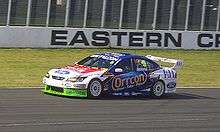
Ford has campaigned touring cars such as the Focus, Falcon, and Contour/Mondeo and the Sierra Cosworth in many different series throughout the years. Notably, Mondeo drivers finished 1,2,3 in the 2000 British Touring Car Championship and Falcon drivers placed 1,2,3 in the 2005 V8 Supercar Championship Series.
Drag racing
In drag racing, John Force Racing drivers John Force, Tony Pedregon, and Robert Hight have piloted Ford Mustang Funny Cars to several NHRA titles in recent seasons. Teammates Tim Wilkerson and Bob Tasca III also drive Mustangs in Funny Car.
Drifting
Ford has branched out into drifting with the introduction of the new model Mustang. Most noticeable is the Turquoise and Blue Falken Tires Mustang driven by Vaughn Gittin, Jr., (A.K.A. "JR") that produces 750 RWHP (Rear Wheel Horsepower).
Environmental initiatives
Compressed natural gas
The alternative fossil fuel vehicles, such as some versions of the Crown Victoria especially in fleet and taxi service, operate on compressed natural gas—or CNG. Some CNG vehicles have dual fuel tanks – one for gasoline, the other for CNG – the same engine can operate on either fuel via a selector switch.
Flexible fuel vehicles
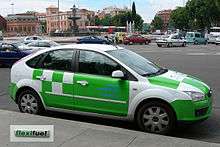
Flexible fuel vehicles are designed to operate smoothly using a wide range of available ethanol fuel mixtures—from pure gasoline to bioethanol-gasoline blends such as E85 (85% ethanol and 15% gasoline) or E100 (neat hydrous ethanol) in Brazil. Part of the challenge of successful marketing alternative and flexible fuel vehicles in the U.S. is the general lack of establishment of sufficient fueling stations, which would be essential for these vehicles to be attractive to a wide range of consumers. Significant efforts to ramp up production and distribution of E85 fuels are underway and expanding.[161] Current Ford E100 Flex sold in the Brazilian market are the Courier, Ford EcoSport, Ford Fiesta, Ford Focus, and Ford Ka.
Electric drive vehicles
Hybrid electric vehicles
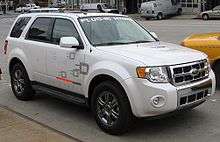
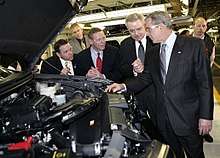
In 2004, Ford and Toyota agreed a patent sharing accord which granted Ford access to certain hybrid technology patented by Toyota; in exchange, Ford licensed Toyota some of its own patents.[162][163][164] In 2004, Ford introduced the Escape Hybrid. With this vehicle, Ford was third to the automotive market with a hybrid electric vehicle and the first hybrid electric SUV to market. This was also the first hybrid electric vehicle with a flexible fuel capability to run on E85.[165] The Escape's platform mate Mercury Mariner was also available with the hybrid-electric system in the 2006 model year—a full year ahead of schedule. The similar Mazda Tribute will also receive a hybrid-electric powertrain option, along with many other vehicles in the Ford vehicle line.
In 2005, Ford announced a goal to make 250,000 hybrids a year by 2010, but by mid-2006 announced that it would not meet that goal, due to excessively high costs and the lack of sufficient supplies of the hybrid-electric batteries and drivetrain system components.[166] Instead, Ford has committed to accelerating development of next-generation hybrid-electric power plants in Britain, in collaboration with Volvo. This engineering study is expected to yield more than 100 new hybrid-electric vehicle models and derivatives.
In September 2007, Ford announced a partnership with Southern California Edison (SCE) to examine how plug-in hybrids will work with the electrical grid. Under the multimillion-dollar, multi-year project, Ford will convert a demonstration fleet of Ford Escape Hybrids into plug-in hybrids, and SCE will evaluate how the vehicles might interact with the home and the utility's electrical grid. Some of the vehicles will be evaluated "in typical customer settings", according to Ford.[29][30]
On June 12, 2008, USDOE expanded its own fleet of alternative fuel and advanced technology vehicles with the addition of a Ford Escape Plug-In Hybrid Flex-Fuel Vehicle. The vehicle is equipped with a 10-kilowatt (13 hp) lithium-ion battery supplied by Johnson Controls-Saft that stores enough electric energy to drive up to 30 miles (48 km) at speeds of up to 40 mph (64 km/h).[167] In March 2009, Ford launched hybrid versions of the Ford Fusion Hybrid and the Mercury Milan Hybrid in the United States, both as 2010 models.[168]
As of November 2014, Ford has produced for retail sales the following hybrid electric vehicles: Ford Escape Hybrid (2004–2012), Mercury Mariner Hybrid (2005–2010), Mercury Milan Hybrid (2009–2010), Ford Fusion Hybrid (2009–present), Lincoln MKZ Hybrid (2010–present), Ford C-Max Hybrid (2012–present), and Ford Mondeo Hybrid (2014–present). By June 2012, Ford had sold 200,000 full hybrids in the US since 2004,[169] and, as of September 2014, the carmaker has sold over 344 thousand hybrids in the United States.[169][170][171][172] The top selling hybrids in the U.S. market are the Fusion Hybrid with 127,572 units, followed by Escape Hybrid with 117,997 units, and the C-Max Hybrid with 54,236.[170][171][172][173][174] As of November 2014, Ford is the world's second largest manufacturer of hybrids after Toyota Motor Corporation, with 400,000 hybrid electric vehicles produced since their introduction in 2004.[175]
Plug-in electric vehicles
As of October 2014, Ford has produced the following plug-in electric vehicles: the all-electric Ford Ranger EV (1997–2002), Ford TH!NK (1999–2003), Transit Connect (2010–2012), and Ford Focus Electric (December 2011–present); and the plug-in hybrids C-MAX Energi (October 2012–present) and the Fusion Energi (February 2013–present), sold under the Mondeo nameplate in Europe.[176][177] Since the launch of the Focus Electric in 2011, combined sales of all Ford plug-in electric models amounted to just over 56,000 through October 2015.[178]

Bill Ford was one of the first top industry executives to make regular use of a battery electric vehicle, a Ford Ranger EV, while the company contracted with the United States Postal Service to deliver electric postal vans based on the Ranger EV platform. Ford discontinued a line of electric Ranger pickup trucks and ordered them destroyed, though it reversed in January 2005, after environmentalist protest.[179] The all-electric pickup truck leased 205 units to individuals and 1,500 units to fleets in the U.S. from 1998 to 2002.[180][181]
From 2009 to 2011, Ford offered the Ford TH!NK car. Ford ended production and ordered all the cars repossessed and destroyed, even as many of the people leasing them begged to be able to buy the cars from Ford. After outcry from the lessees and activists in the US and Norway, Ford returned the cars to Norway for sale.[182] 440 units were leased in the U.S. from 1999 until 2003.[181]
In 2017, CEO of Ford Mark Fields announced that the company will invest $4.5 billion in further development of plug-in electric vehicles by 2020.[183]
The Azure Transit Connect Electric was an all-electric van developed as a collaboration between Azure Dynamics and Ford Motor Company, but Azure was the official manufacturer of record.[184] The Transit Connect Electric had an official US Environmental Protection Agency all-electric range of 56 mi (90 km).[185] The EPA rated the combined city/highway fuel economy at 62 miles per gallon gasoline equivalent (3.8 L/100 km equivalent).[185] Deliveries for fleet customers in the U.S. and Canada began in December 2010.[186] Production of the electric van was stopped in March 2012 as a result of Azure's bankruptcy protection filing. Ford continues to provide servicing.[187] Around 500 units were sold before Azure stopped production.[188]
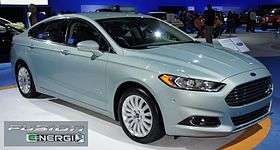
The Ford Focus Electric is based on the next generation Focus internal combustion vehicle, converted to an all-electric propulsion system as a production electric car by Magna International, and retail sales began in the U.S. in December 2011.[189][190] The Focus Electric has an EPA rated range of 76 mi (122 km) and a combined city/highway fuel economy of 105 miles per gallon gasoline equivalent (2.2 L/100 km).[191] Available also in Canada and several European countries, 3,965 units have been sold in the U.S. through September 2014.[170][171][172][192]
The Ford C-Max Energi is a plug-in hybrid released in the U.S. in October 2012. The C-Max Energi has an EPA rated all-electric range of 20 mi (32 km) and a combined city/highway fuel economy in all-electric mode at 88 MPG-e (2.7 L/100 km).[193] U.S. sales totaled 33,509 units through December 2016.[170][171][194][195][196] Deliveries of the Ford Fusion Energi began in the United States in February 2013.[197][198] The Fusion Energi has an all-electric range of 20 mi (32 km) and an equivalent fuel economy EPA rating of 88 MPG-e (2.7 L/100 km).[193] As of December 2016, a total of 43,327 units have been delivered in the U.S. since its inception.[171][194][195][196]
Both Energi models share the same powertrain technology and have the same EPA combined city/highway fuel economy in hybrid operation of 38 mpg‑US (6.2 L/100 km; 46 mpg‑imp).[193] When asked about a battery-electric vehicle with a 200-mile (320 km) range, Fields said in April 2016 "Clearly that's something we're developing for". Ford has a pending trademark application on the "Model E" name,[199] preventing the Tesla Model 3 in using the name.[200]
In October 2017, Ford announced its Team Edison battery-electric vehicle group to lead the company's renewed efforts into the EV market, in which it currently offers only the Focus subcompact and has plans for a small 300-mile SUV by 2020.[201] The new team will be headquartered in Detroit and have offices in Europe and Asia.[202]
Hydrogen
Ford also continues to study fuel cell-powered electric powertrains and has demonstrated hydrogen-fueled internal combustion engine technologies, as well as developing the next-generation hybrid-electric systems. Compared with conventional vehicles, hybrid vehicles and/or fuel cell vehicles decrease air pollution emissions as well as sound levels, with favorable impacts upon respiratory health and decrease of noise health effects.
Ford has launched the production of hydrogen-powered shuttle buses, using hydrogen instead of gasoline in a standard internal combustion engine, for use at airports and convention centers.[203] At the 2006 Greater Los Angeles Auto Show, Ford showcased a hydrogen fuel cell version of its Explorer SUV. The Fuel cell Explorer has a combined output of 174 hp (130 kW). It has a large hydrogen storage tank which is situated in the center of the car taking the original place of the conventional model's automatic transmission. The centered position of the tank assists the vehicle reach a notable range of 350 miles (563 km), the farthest for a fuel cell vehicle so far. The fuel cell Explorer the first in a series of prototypes partly funded by the United States Department of Energy to expand efforts to determine the feasibility of hydrogen- powered vehicles. The fuel cell Explorer is one of several vehicles with green technology being featured at the L.A. show, including the 2008 Ford Escape Hybrid, PZEV emissions compliant Fusion and Focus models and a 2008 Ford F-Series Super Duty outfitted with Ford's clean diesel technology.
Increased fuel efficiency
Ford Motor Company announced it will accelerate its plans to produce more fuel-efficient cars, changing both its North American manufacturing plans and its lineup of vehicles available in the United States. In terms of North American manufacturing, the company will convert three existing truck and sport utility vehicle (SUV) plants for small car production, with the first conversion at its Michigan Truck Plant. In addition, Ford's assembly plants near Mexico City, Mexico, and in Louisville, Kentucky, will convert from pickups and SUVs to small cars, including the Ford Fiesta, by 2011. Ford will also introduce to North America six of its European small vehicles, including two versions of the Ford Fiesta, by the end of 2012.
Ford of Europe developed the ECOnetic programme to address the market and legislative need for higher fuel efficiency and lower CO2 emissions. As opposed to the hybrid engine technology used in competitor products such as the Toyota Prius, ECOnetic improves existing technology. Using lower consuming Duratorq TDCi diesel engines, and based on a combination of improved aerodynamics, lower resistance, and improved efficiency, the Ford Fiesta is currently the lowest emitting mass-produced car in Europe[204] while the 2012 Ford Focus ECOnetic will have better fuel consumption than the Prius or the Volkswagen Golf BlueMotion.[205] ECOnetic is not presently planned to be sold in North American due to current perceived lower consumer demand.[206]
Ford has challenged University teams to create a vehicle that is simple, durable, lightweight, and come equipped with a base target price of only $7,000. The students from Aachen University created the "2015 Ford Model T".[207][208]
In 2000, under the leadership of the current Ford chairman, William Clay Ford, the company announced[209] a planned 25 percent improvement in the average mileage of its SUVs – to be completed by the 2005 calendar year. In 2003, Ford announced that competitive market conditions and technological and cost challenges would prevent the company from achieving this goal.[210]
For the 2007 model year, Ford had thirteen U.S. models that achieve 30 miles per gallon or better (based on the highway fuel economy estimates of the EPA) and several of Ford's vehicles were recognized in the EPA and Department of Energy Fuel Economy Guide for best-in-class fuel economy. Ford claimed to have eliminated nearly three million pounds of smog-forming emissions from their U.S. cars and light trucks over the 2004 to 2006 model years.[211] However, the United States Environmental Protection Agency has linked Ford to 54 Superfund toxic waste sites, twelve of which have been cleaned up and deleted from the list.[212]
PC power management
In March 2010, Ford announced its PC power management system which it developed with NightWatchman software from 1E. The company is expected to save $1.2m on power cost and reduce carbon footprint by an estimated 16,000 to 25,000 metric tons annually when the system is fully implemented.
According to company, reduction in carbon footprint and power cost will be achieved by developing 'Power Profiles' for every PC in the company.[213]
Sponsorships
Ford sponsors numerous events and sports facilities around the US, most notably the Ford Center in downtown Evansville, Indiana, and Ford Field in downtown Detroit.[214]
Ford has also been a major sponsor of the UEFA Champions League for over two decades and is also a longtime sponsor of the Sky media channel's coverage of Premier League football. Senior Ford marketer Mark Jones explained in May 2013 the process behind the two sponsorship deals:
We start with a blank piece of paper and work out if the sponsorship still works for us and ask does it meet our objectives? We want to find a moment in time when people come together and have a collective experience and we achieve this through the sponsorships.[215]
Sales numbers
| Calendar Year | US sales | Market share
of US sales[216] |
|---|---|---|
| 1997 | 3,877,458[217] | 25.02% |
| 1998 | 3,922,604[218] | 24.52% |
| 1999 | 4,163,369[219] | 23.91% |
| 2000 | 4,202,820 | 23.61% |
| 2001 | 3,971,364 | 22.69% |
| 2002 | 3,623,709[220] | 21.19% |
| 2003 | 3,483,719 | 20.53% |
| 2004 | 3,331,676[221] | 19.26% |
| 2005 | 3,153,875 | 18.08% |
| 2006 | 2,901,090[222] | 17.02% |
| 2007 | 2,507,366 | 15.23% |
| 2008 | 1,988,376[223] | 14.74% |
| 2009 | 1,620,888[224] | 15.29% |
| 2010 | 1,935,462[225] | 16.44% |
| 2011 | 2,143,101[226] | 16.42% |
| 2012 | 2,250,165[227] | 15.22% |
| 2013 | 2,493,918[228] | 15.70% |
| 2014 | 2,480,942[229] | 14.72% |
| 2015 | 2,613,162[230] | 14.64% |
| 2016 | 2,614,697[231][232] | 14.63% |
| 2017 | 2,586,715[233] | 14.74% |
| 2018 | 2,497,318[233] | 14.13% |
| 2019 | 2,422,698[234] | 13.8% |
See also
References
- Hyde, Charles K. (June 2005). "National Historic Landmark Nomination – Ford Piquette Avenue Plant" (PDF). National Park Service. p. 11. Archived from the original (PDF) on February 22, 2017. Retrieved August 18, 2017.
- "Ford Motor Company 2019 Annual Report (Form 10-K)" (PDF). sec.gov. U.S. Securities and Exchange Commission. January 2020.
- "Ford Motor Company (F) Company Profile, News, Rankings". Fortune. Retrieved May 25, 2020.
- "Ford Motor Company (F) Income Statement". Yahoo Finance. Retrieved May 25, 2020.
- "Ford Motor Company company : Shareholders, managers and business summary". 4-Traders. France. Retrieved May 15, 2016.
- Rogers, Christina (May 12, 2016). "Shareholders Again Back Ford Family". Wall Street Journal. Retrieved September 16, 2016.
- "Jiangling Motors Corporation, Ltd. 2017 Annual Report" (PDF). JMC. pp. 27, 29. Retrieved February 1, 2019 – via Sohu.
- Muller, Joann (December 2, 2010). "Ford Family's Stake Is Smaller, But They're Richer And Still Firmly In Control". Forbes. Retrieved August 31, 2016.
- "Ford Motor Company Completes Sale of Volvo to Geely". Ford Motor Co. August 2, 2010. Archived from the original on August 3, 2010. Retrieved August 2, 2010.
- "New Passenger Car Registrations by Manufacturer European Union (EU)". ACEA. Archived from the original on September 27, 2011. Retrieved January 28, 2011.
- Muller, Joann (March 9, 2014). "William Clay Ford's Legacy Cemented Family's Dynasty". Forbes.
- Hammond, Lou Ann. "How Ford stayed strong through the financial crisis - Jan. 13, 2011". Fortune. Retrieved December 20, 2017.
- "Ford Motor". Fortune. Retrieved November 9, 2018.
- "Ford Motor Company / 2008 Annual Report, Operating Highlights" (PDF). p. 1. Archived from the original (PDF) on April 19, 2011. Retrieved September 19, 2010.
- McDonough, John; Egolf, Karen (June 18, 2015). The Advertising Age Encyclopedia of Advertising. Routledge. ISBN 9781135949068.
- "1930 model brochure – Beauty of Line – Mechanical excellence". Ford. 1929. Retrieved May 24, 2012.
- Shpotov, Boris M. (August 2006). "The Ford Motor Company in the Soviet Union in the 1920s-1930s: Strategy, identity, performance, reception, adaptability" (PDF). International Economic History Congress. Retrieved August 8, 2016.
- Johnson, Ann (October 27, 2014). "How the Ford Motor Co. Invented the SQUID". IEEE Spectrum. Retrieved December 19, 2014.
- "1956 Ford Fairlane Brochure". Ford. 1955. Retrieved May 24, 2012.
- "Photo gallery, timeline: 50 years of Ford Mustangs". USA TODAY. Retrieved December 20, 2017.
- Goldberg, Aaron H. (2016). The Disney Story: Chronicling the Man, the Mouse and the Parks. Quaker Scribe Publishing. ISBN 978-0-692-76636-1. Retrieved February 13, 2020.
- "The History of Ford Motor Company". GearHeads. May 17, 2012. Retrieved June 22, 2012.
- Leggett, Theo (March 6, 2005). "Ford fighting to keep its shine". BBC News. Retrieved September 19, 2010.
- Schneider, Greg (May 6, 2005). "GM, Ford Bond Ratings Cut to Junk Status". The Washington Post. Retrieved September 19, 2010.
- "Rebate wars - Chicago Sun-Times - Find Articles at BNET.com". January 3, 2008. Archived from the original on January 3, 2008.
- Maynard, M.; Bajaj, V. (January 23, 2006). "Ford to Cut Up to 30,000 Jobs and 14 Plants in Next 6 Years". The New York Times.
- Zaun, Todd; Hakim, Danny (March 10, 2004). "Ford to License Toyota's Hybrid Technology". The New York Times. Retrieved September 19, 2010.
- Nussbaum, Bruce (November 1, 2005). "Is Ford Innovative? Part Two". Business Week. Retrieved September 19, 2010.
- "EERE News: EERE Network News". Eere.energy.gov. September 15, 2010. Retrieved September 19, 2010.
- Ford Motor Company – Press Release – Ford Motor Company And Southern California Edison Join Forces To Advance A New Transportation And Energy Vision Archived October 11, 2007, at the Wayback Machine
- "Ford Bets The House". The Detroit News. November 28, 2006. Retrieved September 19, 2010.
- Levine, Greg (April 5, 2006). "Ford CEO: 'Honesty' Best Weapon Against Bankruptcy". Forbes. Retrieved September 19, 2010.
- Isidore, Chris (January 25, 2007). "Ford: Biggest loss ever". CNN. Retrieved May 2, 2010.
- "Ford hit by record $12.7bn loss". BBC News. January 25, 2007. Retrieved September 19, 2010.
- "Ford takes $2.4bn writedown for Volvo". FinancialTimes. January 24, 2008. Retrieved September 19, 2010.
- "Tata Motors completes acquisition of Jag, Land Rover". Thomson Reuters. June 2, 2008. Retrieved June 2, 2008.
- "On U.S. tour, Mr. Tata gives Jaguar and Rover dealers a hug: AutoWeek Magazine". Autoweek.com. Archived from the original on January 17, 2012. Retrieved June 18, 2009.
- Ford's Mulally Testifies to Senate on November 18, 2008. Retrieved November 30, 2013.
- "Ford Exec: 'We Are Sensitive To Public Opinion'". NPR.org. November 25, 2008. Retrieved February 25, 2013.
- "Detroit Chiefs Plead for Aid". The New York Times. November 18, 2008. Retrieved November 21, 2008.
- Herszenhorn, David M.; Sanger, David E. (December 19, 2008). "Bush offers emergency loans up to $17.4 billion to GM and Chrysler". The New York Times. Arthur Ochs Sulzberger, Jr., The New York Times Company. Retrieved December 30, 2015.
- Brettell, Karen (December 19, 2008). "GM, Ford default swaps fall on Bush bailout plan". Reuters.
- Dolan, Matthew D.; Stoll, John D. (April 7, 2009). "Ford Trims Debt 28%". The Wall Street Journal. Retrieved July 23, 2009.
- Bunkley, Nick (January 28, 2010). "Ford Profit Comes as Toyota Hits a Bump". The New York Times. Retrieved February 2, 2010.
- Bomey, Nathan. "The Blue Oval is Ford's again as credit upgrade frees automaker's assets from mortgage". Detroit Free Press.
- Prasad, Sakthi (October 29, 2012). "Ford to sell climate control business to Detroit Thermal Systems". Reuters.
- "Ford's Mulally Stays Through 2014, Fields Is COO". The New York Times.
- Durbin, Dee-Ann; Krisher, Tom (January 8, 2014). "Mulally puts the focus back on Ford's cars, trucks". ap.org. Retrieved January 8, 2014.
- See how Fairlane Mall will transform because of Ford Motor Company, mlive.com, May 10, 2016
- Ford unveils 10-year plan to transform Dearborn campus, Michael Martinez, The Detroit News, April 12, 2016
- Ford redevelopment plan in Dearborn estimated at $1.2B, Brent Snavely, Detroit Free Press, April 12, 2016
- "Ford cancels Mexico plant. Will create 700 U.S. jobs in 'vote of confidence' in Trump". FOX2now. USA. January 3, 2017. Retrieved January 3, 2017.
- "How Ford plans to use its new Corktown digs". Crain's Detroit Business. January 21, 2018. Retrieved June 19, 2018.
- "Ford's future: Train station to be part of new transportation model". Crain's Detroit Business. June 16, 2018. Retrieved June 19, 2018.
- "How Ford plans to resurrect the train station". Detroit News. Retrieved June 19, 2018.
- "A renaissance, new age of mobility moves into Corktown". June 19, 2018.
- Higgins, Tim (February 10, 2017). "Ford Acquires Majority Ownership of Self-Driving Car Startup Argo AI". The Wall Street Journal. New York City. Retrieved February 12, 2017.
- Martinez, Michael (May 17, 2017). "Ford to cut 1,400 salaried jobs in North America, Asia". Automotive News. Retrieved May 17, 2017.
- Bomey, Nathan (May 17, 2017). "Ford to slash 10% of salaried jobs in North America, Asia". USA Today. Retrieved May 17, 2017.
- "Who is Jim Hackett, Ford's new CEO". USA TODAY. Retrieved May 22, 2017.
- Stoll, John D. "Ford to replace CEO Mark Fields with Jim Hackett". MarketWatch. Retrieved May 22, 2017.
- Krisher, Tom. "Ford to discontinue all cars except for Mustang and Focus hatch". chicagotribune.com. Retrieved May 14, 2018.
- Kautonen, Antti (August 31, 2018). "Ford cancels Focus Active import plans due to China tariffs". Autoblog. US. Retrieved September 13, 2018.
- Domonoske, Camila (September 10, 2018). "Ford Says Despite Trump's Tweet, Focus Active Won't Be Produced In U.S." NPR. US. Retrieved September 13, 2018.
- "Ford, GM, Fiat Chrysler, and United Auto Workers union agree to a partial shutdown of US plants as coronavirus spreads, despite many in Europe shutting down completely". Business Insider. Retrieved March 18, 2020.
- Matthew DaBord. "Ford says it won't restart North American factories at the end of March because of the coronavirus outbreak". Business Insider. Retrieved March 24, 2020.
- Sherman, Natalie (April 28, 2020). "Cars out, snacks in as virus impacts US profits". BBC News. Retrieved April 30, 2020.
- "Members of the Board". Ford Motor Company Media Center. Retrieved October 11, 2018.
- Colias, Mike (August 4, 2020). "Ford Names Jim Farley as New CEO, Succeeding Jim Hackett". The Wall Street Journal. Retrieved August 4, 2020.
- "Ford Motor Company Fund 2017 Annual Report" (PDF). Ford.
- "The Ford Fund".
Since we began our operations in 1949, we have invested nearly $1.5 billion in civic organizations around the world to help drive a brighter future.
- Fritz, Joanne. "What Are Foundations? What Nonprofits Should Know". The Balance Small Business. Retrieved January 23, 2019.
- "Ford Motor Company - Investors - Sustainability". shareholder.ford.com. Retrieved January 23, 2019.
- "Ford Motor Company Fund/Ford Driving Skills for Life". US: Governors Highway Safety Association. Retrieved January 13, 2019.
- "Ford Volunteer Corps Begins Global Caring Month With Transformational Clean Water Project, Challenge Grants".
- "Ford Motor Company Fund & Community Services: Grants for K-12 Education". Inside Philanthropy. Retrieved January 23, 2019.
- Isidore, Chris (June 2, 2010). "GM, Ford sales gains outpace Toyota". CNNMoney.com.
- Boudette, Neal E.; Terlep, Sharon (June 14, 2010). "Auto-Sales Optimism Fades". The Wall Street Journal.
- Snyder, Jesse (August 9, 2010). "Fleets fuel surge at GM, Chrysler". Automotive News.
- "Back to the future for Ford". The Engineer. October 26, 2007. Retrieved February 28, 2012.
- Ewing, Jack (November 5, 2013). "Ford Pays a High Price for Plant Closing in Belgium". The New York Times. Retrieved October 16, 2019.
- "Ford bekräftigt Engagement in Spanien: 750 Millionen Euro für Kuga-Fertigung in Valencia". PressePortal (in German). November 17, 2017. Retrieved October 16, 2019.
- "FORD STARTET PRODUKTION DES NEUEN FORD ECOSPORT IN RUMÄNIEN" (Press release) (in German). Ford. October 12, 2017. Retrieved October 16, 2019.
- Grundhoff, Stefan (April 11, 2019). "Ford will sein Werk Craiova mit Puma voll auslasten". automobil-produktion.de (in German). Retrieved October 16, 2019.
- "Ford to build low capacity car engines at hotnews.ro". English.hotnews.ro. Retrieved September 19, 2010.
- "Union: Ford to Close Belgian Plant in 2014". The New York Times. October 24, 2012.
- "Ford takes control of Russia joint venture". Reuters. April 10, 2015.
- "Factbox: U.S. companies with exposure to Russia". Reuters. August 9, 2018.
- Williams, Evan (September 28, 2018). "Ford Turkey Shows Off F-Vision Concept Electric Semi". AutoTrader.ca.
- Naughton, Keith (April 15, 2013). "Ford Outsells Toyota in China as $4.9 Billion Bet Pays". Bloomberg.
- "About Ford Thailand". Ford.co.th. Archived from the original on July 27, 2011. Retrieved September 19, 2010.
- Maierbrugger, Arno (May 1, 2013). "Ford rolls into Myanmar's car market". Inside Investor. Retrieved July 12, 2013.
- "Kia Motors Corporation History". Funding Universe. Retrieved July 13, 2012.
- "Kia Motors Corporation". Hoovers.com. October 21, 2010. Retrieved April 24, 2011.
- "Ford Korea" (in Korean). Retrieved May 24, 2020.
- "Lincoln Korea" (in Korean). Retrieved May 24, 2020.
- "Ford launches Figo compact, hopes for cool entry into India's hot auto market". Guelph Mercury. Donna Luelo, Metroland Media Group. March 9, 2010. Retrieved December 30, 2015.
- "Ford Announces Manufacturing and Engine Plant in Gujarat, India". July 28, 2011. Archived from the original on March 20, 2012.
- "Ford forms JV with Mahindra for India business". Reuters. October 1, 2019. Retrieved October 1, 2019.
- "Ford Motor Company: Global Websites". Archived from the original on January 18, 2006.
- Tignor, Robert, L. (Summer 1990). "In The Grip Of Politics: The Ford Motor Company Of Egypt, 1945–1960". Middle East Journal. 44 (3): 383–398. JSTOR 4328139.
- "Al Jazirah Vehicles Hits 100,000 Mark with Ford and Lincoln in Saudi Arabia". Archived from the original on May 3, 2006.
- Ford Automotive Operations - Latin America Archived July 11, 2011, at the Wayback Machine - Retrieved November 3, 2011
- www.ford.com Archived April 24, 2008, at the Wayback Machine Ford Motor Company Global Operations - accessed December 1, 2008
- "Folha de S.Paulo - Ford e Volks anunciam fim da Autolatina;Nova direção - 2/12/1994". www1.folha.uol.com.br. Retrieved October 10, 2017.
- Moseley, Ray (October 25, 1985). "South Africa's Shrinking Auto Industry". Chicago Tribune. Retrieved October 14, 2016.
- Vartabedian, Ralph; Parks, Michael (June 15, 1987). "Ford Discussing Plans to Divest in South Africa : Firm Would Give 24% Stake to Workers, But Maintain a Presence". Los Angeles Times. Retrieved October 14, 2016.
- "Samcor". Financial Mail. 104 (5–9). South Africa. 1987. p. 221.
- Reuvid, Jonathan; Page, Kogan (1995). Doing Business in South Africa. p. 270. ISBN 9780749413477.
- Will Ford drop the Fusion after 2020?, Independent Online, 8 January 2018
- della Cava, Marco (January 22, 2015). "Ford's new Silicon Valley outpost seeks tech talent". USA Today. Retrieved April 28, 2019.
- Brauer, Karl (January 22, 2015). "Ford Opens New Research and Innovation Center in Palo Alto". Forbes. US. Retrieved April 28, 2019.
- Rogers, Christina (January 22, 2015). "Ford Opens Palo Alto Engineering Center". Wall Street Journal. US. Retrieved April 28, 2019.
- Mearian, Lucas (January 22, 2015). "Ford opens autonomous vehicle R&D center in Tesla territory". Computerworld. US. Retrieved April 28, 2019.
- Kuswaraharja, Dadan (January 25, 2016). "Ford Mundur dari Indonesia" [Ford backwards from Indonesia]. DetikOto (in Indonesian). detikcom. Retrieved January 27, 2016.
- Danubrata, Eveline; Cahya, Yuddy (June 27, 2016). "Ford's Indonesian dealers demand compensation after abrupt withdrawal". Reuters. Retrieved January 25, 2020.
- "Ford's System of Branch Assembly Plants". Ford Motor Company History. August 22, 2007. Retrieved July 31, 2017.
- "Automotive Intelligence". Autointell.com. Retrieved August 16, 2013.
- Gremimel, Hans (August 24, 2015). "How Ford's partnership with Mazda unraveled". Automotive News. Retrieved July 26, 2016.
- Schmitt, Bertel (January 26, 2016). "It's Ford's Fault That It Couldn't Compete In Japan". Forbes. Retrieved July 26, 2016.
- "Ford to exit Japan, citing its 'closed' market". The Japan Times. January 26, 2016. Retrieved July 26, 2016.
- "Kia soars ahead of the others". The New Zealand Herald. September 20, 2006.
- Spinks, Jez (August 2, 2011). "No regrets about Aussie Focus: Ford". Drive. Australia. Retrieved January 25, 2020.
- Robertson, David (June 16, 1986). "Australia Welcomes The 'new' Migrants". The Age. p. 43.
- de Fraga, Christopher (June 1, 1984). "Family tree bears fruit". The Age. p. 18. Retrieved September 8, 2016.
- "Transactions of the Institution of Engineers, Australia: Mechanical engineering". 15-16. Australia: Institution of Engineers. 1989: 163. Cite journal requires
|journal=(help) - "The Motor". The Motor. Vol. 168. Temple Press Limited. 1985. p. 32.
- Davison, Remy (May 24, 2013). "Ford's exit spells the end of the road for manufacturing". The Conversation Australia. The Conversation Media Group. Retrieved May 26, 2013.
- "Ford To Expand Lincoln Lineup and Brand Emphasis; Mercury Production Ends In Fourth Quarter of 2010" (Press release). Ford Motor Company. June 2, 2010.
- "Ford Announces Agreement to Sell Aston Martin" (Press release). Ford Motor Company. March 12, 2007. Archived from the original on April 10, 2013. Retrieved February 6, 2013.
- Bunkley, Nick (March 12, 2007). "Ford sells Aston Martin unit". The New York Times. Retrieved February 6, 2013.
- Lee, Steven (November 12, 2012). "Aston Martin main owner is looking for buyers". Daily Press. Retrieved February 6, 2013.
- "AB Volvo – press release". Cision. January 28, 1999.
- "Ford to Sell 20% Stake in Mazda". Agence France-Presse. November 18, 2008. Retrieved April 15, 2018.
- "Ford to Change Stake in Mazda". Ford Motor Company. November 18, 2010. Retrieved March 9, 2011.
- "Automaker tie-ups: Ford sells remaining stake in Mazda". Nikkei Asian Review. November 14, 2015. Retrieved February 25, 2017.
- "Ford will only sell two kinds of cars in America". The Verge. Retrieved April 26, 2018.
- Kent, Gordon (June 1986). "Intertruck: Britain". TRUCK. London, UK: FF Publishing Ltd: 39.
- "Daimler Trucks North America Plans Decisive Response to Changed Economic Environment". Retrieved June 18, 2009.
- "Sterling Trucks launched with three models". Fleet Owner. March 1, 1998. Retrieved June 29, 2018.
- "Ford, Navistar join Forces to create Blue Diamond Truck Company" (Press release). Ford Motor Company. August 7, 2001. Retrieved February 4, 2010.
- Weber, Rick (November 2004). "Ford enters LCF commercial market". Trailer Body Builders.com. Penton Media, Inc. Archived from the original on July 17, 2011. Retrieved February 4, 2011.
- Weber, Rick. "LCF Update 2009". Fordtrucksonline. HDG/Battlefield Ford. Archived from the original on December 26, 2010. Retrieved February 4, 2011.
- Ford UK Commercial Vehicles. ford.co.uk. Retrieved June 9, 2010.
- "Ford Buses". Motor Coach Age. Motor Bus Society. 45 (3–4): 24–31. March–April 1992. ISSN 0739-117X.
- H.B. Craig, II (September 9, 1945). "Bus Photos 1940's – Pg.1". Detroit Transit History.Info. Retrieved January 27, 2012.
- Ford UK Minibus. Archived May 10, 2010, at the Wayback Machine ford.co.uk. Retrieved June 9, 2010.
- "1935 Miller-Ford Race Car". The Henry Ford.
- Ernst, Kurt (August 10, 2016). "Preston Tucker's prewar debacle: The 1935 Miller Ford V-8 Indy Car". Hemmings Daily. Hemmings. Retrieved June 6, 2018.
- McGann, John (April 2, 2013). "Horsepower! – Ford Indy V8". HotRod Network. MotorTrend Group. Retrieved June 6, 2018.
- "Graham Hill's 'American Red Ball Spl' Lola T90 Ford: Indy Winner 1966..." Primotipo. June 12, 2015. Retrieved June 6, 2018.
- Horrow, Ellen J. (May 28, 2017). "Year-by-Year Indianapolis 500 Winners Since 1911". USA Today. Archived from the original on August 31, 2017. Retrieved June 6, 2018.
- Glick, Shav (May 13, 1996). "Luyendyk Roars at Indianapolis". Los Angeles Times. Archived from the original on October 17, 2015. Retrieved June 6, 2018.
- "IRL: Indy 500: Track Notes". Motorsport.com. April 30, 2002. Archived from the original on June 6, 2018. Retrieved June 6, 2018.
- "Indianapolis 500 Qualifying Records". Indianapolis Motor Speedway, LLC. Archived from the original on June 6, 2018. Retrieved June 6, 2018.
- Moffitt, Alastair (November 15, 2004). "Red Bull give Jaguar F1 wings". London: Red Bull give Jaguar F1 wings. Archived from the original on May 27, 2007.
- Held, Scott (June 16, 2013). "Biffle emerges late, lands Michigan victory". NASCAR. Retrieved June 16, 2013.
- Graham, Neale (November 20, 2006). "Rallying: Gronholm victory delivers manufacturers' title to Ford". The Independent. London. Archived from the original on December 20, 2007. Retrieved May 2, 2010.
- "Statistics – Longest make points finish streaks". juwra.com. Retrieved September 30, 2010.
- Joseph, Noah (November 9, 2015). "Ford Performance and Michelin sign performance tire deal". Autoblog. Retrieved December 14, 2015.
- "Alternative Power: Michigan sets sights on ethanol to become an energy hotbed". Archived from the original on September 5, 2006.
- Zaun, Todd (March 10, 2004). "Ford to Use Toyota's Hybrid Technology – The New York Times". The New York Times. Retrieved August 1, 2009.
- Takahashi, Yoshio (March 9, 2004). "Toyota to License Hybrid Patents For Use by Ford". The Wall Street Journal. Retrieved August 1, 2009.
- Eldridge, Earle (March 9, 2004). "Ford borrows from Toyota's blueprints for new hybrid Escape". USA Today. Retrieved August 1, 2009.
- "Ford Develops World's First Ethanol-Fueled Hybrid Marrying Two Gasoline-Saving Technologies". Archived from the original on February 4, 2006.
- Vanzieleghem, Bruno (June 29, 2006). "Bill Ford eats his words: No 250,000 hybrids a year by 2010". autoblog.com. Retrieved August 27, 2009.
- "EERE News: DOE to Award $30 Million for Plug-In Hybrid Electric Vehicle Demonstrations". Apps1.eere.energy.gov. June 12, 2008. Retrieved June 18, 2009.
- "US Hybrid Sales in March 2009 Down 44% Year-on-Year; Monthly New Vehicle Market Share of 2.5%". Green Car Congress. April 3, 2009. Retrieved June 6, 2009.
- Nichols, Will (June 25, 2012). "Ford tips hybrids to overshadow electric cars". Business Green. Retrieved October 16, 2012. By June 2012 Ford had sold 200,000 full hybrids in the US since 2004.
- Cobb, Jeff (January 8, 2013). "December 2012 Dashboard". HybridCars.com and Baum & Associates. Retrieved February 9, 2013. See the section: December 2012 Plug-in Electric Car Sales Numbers
- Cobb, Jeff (January 6, 2014). "December 2013 Dashboard". HybridCars.com and Baum & Associates. Retrieved January 7, 2014.
- Cobb, Jeff (October 2, 2014). "September 2014 Dashboard". HybridCars.com and Baum & Associates. Retrieved October 5, 2014.
- "December 2011 Dashboard: Sales Still Climbing". HybridCARS.com. January 9, 2012. Archived from the original on January 12, 2012. Retrieved January 10, 2012.
- "Alternative Fuel Vehicles (AFVs) and Hybrid Electric Vehicles (HEVs): Trend of sales by HEV models from 1999–2010". Alternative Fuels and Advanced Vehicle Data Center (U.S. DoE). Retrieved March 5, 2011. Click and open the Excel file for sales detail by year for each model – Sales 1999–2010
- Crowe, Philippe (November 28, 2014). "Ford Mondeo Hybrid Now In EU Production". HybridCars.com. Retrieved November 30, 2014.
- "Ford CEO Mullaly expects "major portion" of Fords will be electric within a decade". autoblog.com. Retrieved September 30, 2010.
- "EERE News: Chrysler, Ford, and Other Automakers Pursue Electric Vehicles". Apps1.eere.energy.gov. January 14, 2009. Retrieved June 18, 2009.
- Abuelsamid, Sam (November 11, 2015). "Ford On Pace To Sell 1 Million EcoBoost Engines In U.S. In 2015". Forbes. Retrieved November 20, 2015.
- Lydersen, Kari. "Activists Deride Ford over Fuel Inefficiency, ?Greenwashing? – The NewStandard". Newstandardnews.net. Retrieved September 30, 2010.
- Dixon, Lloyd; Porche, Isaac; Kulick, Jonathan (2002). Driving Emissions to Zero: Are the Benefits of California's Zero Emission Vehicle Program Worth the Costs? (PDF). Rand Corporation. ISBN 0-8330-3212-7. Retrieved April 4, 2010. See Appendix E: Table E.1, pp. 124
- Sherry Boschert (2006). Plug-in Hybrids: The Cars that will Recharge America. New Society Publishers, Gabriola Island, Canada. ISBN 978-0-86571-571-4.
- "TH!NK Again: Ford Does a U-Turn". Greenpeace. September 17, 2004. Archived from the original on June 9, 2006. Retrieved June 18, 2006.
- "China, Europe drive shift to electric cars - EvoNews". January 15, 2017. Archived from the original on February 2, 2017. Retrieved January 25, 2017.
- Dolan, Matthew (September 24, 2010). "Ford Works with Manufacturer for New Electric Van". The Wall Street Journal. Retrieved November 1, 2011.
- "Compare side-by-sidy: 2012 Azure Dynamics Transit Connect Electric Van". US Environmental Protection Agency. Retrieved October 5, 2014.
- Bunkley, Nick (December 7, 2010). "Ford Starts to Ship an Electric Delivery Van". New York Times. Retrieved December 10, 2010.
- Blanco, Sebastian (March 28, 2012). "Azure halts Ford Transit Connect Electric production, Ford still confident in EV program". Autoblog Green. Retrieved March 28, 2012.
- Voelcker, John (October 17, 2012). "Nissan e-NV200: Driving Nissan's Prototype Electric Minivan". Green Car Reports. Retrieved October 19, 2012.
- "This page is available to GlobePlus subscribers". The Globe and Mail. Toronto. Archived from the original on September 25, 2013. Retrieved June 18, 2009.
- "More details emerge on Ford's upcoming electric compact – MotorAuthority – Car news, reviews, spy shots". Motor Authority. Archived from the original on June 26, 2009. Retrieved June 18, 2009.
- "2012/2013/2014 Ford Focus Electric". Fueleconomy.gov. U. S. Environmental Protection Agency and U.S. Department of Energy. March 12, 2014. Retrieved March 14, 2014.
- "Chevy Volt continues to lead plug-in sales in US in July". Green Car Congress. August 3, 2012. Retrieved August 4, 2012. 8 units were delivered in December 2011.
- "Compare Side-by-Side – 2013/14 Ford C-Max Plug-in Hybrid and 2013/14 Ford Fusion Plug-in Hybrid". Fueleconomy.gov. U. S. Environmental Protection Agency and U.S. Department of Energy. June 12, 2014. Retrieved June 12, 2014.
- Cobb, Jeff (January 6, 2015). "December 2014 Dashboard". HybridCars.com and Baum & Associates. Retrieved February 7, 2015.
- Cobb, Jeff (January 6, 2016). "December 2015 Dashboard". HybridCars.com and Baum & Associates. Retrieved March 19, 2016.
- Cobb, Jeff (January 5, 2017). "December 2016 Dashboard". HybridCars.com and Baum & Associates. Retrieved February 20, 2017.
- Sears, Jesse (February 27, 2013). "2013 Ford Fusion Energi: Fuel Economy, Pricing and Release Date". Cars Direct. Archived from the original on March 5, 2013. Retrieved March 3, 2013.
- Cole, Jay (March 3, 2013). "February 2013 Plug-In Electric Vehicle Sales Report Card". Inside EVs. Archived from the original on March 4, 2013. Retrieved March 4, 2013.
- Bunkley, Nick (April 28, 2016). "Ford plans EV to compete with Chevy Bolt, Tesla Model 3, Fields confirms". Automotive News. US. Retrieved April 30, 2016.
- Randall, Tom (March 30, 2016). "Elon Musk wanted to name his Model 3 Model E so Tesla's brands would spell SEX. This and other secrets about his newest car". Bloomberg News. Retrieved April 30, 2016.
- "Ford Creates Team Edison to Accelerate Its Efforts in Electric Vehicles". Forbes.
- Hanley, Steve (October 2, 2017). "Team Edison Is Ford's Answer To Tesla". Gas 2. USA. Retrieved January 13, 2019.
- Hoffman, Bryce G (July 18, 2006). "Ford to produce 'green' buses". The Detroit News.
- "Ford Fiesta ECOnetic – UK's greenest car". AutoTrader.co.uk. July 23, 2008. Retrieved April 13, 2011.
- "Ford Focus ECOnetic: 80mpg". AutoTrader.co.uk. April 7, 2011. Retrieved April 13, 2011.
- Kiley, David (September 4, 2008). "The 65 mpg Ford the U.S. Can't Have". BusinessWeek. Retrieved May 9, 2009.
- "Inspiring Innovation: 100 Years Later, Global Students Create 21st Century Model T Concepts, Ford Motor Company Newsroom". Media.ford.com. October 1, 2008. Archived from the original on February 16, 2009. Retrieved June 18, 2009.
- "Details Revealed on Postmodern 2015 Ford Model T and Model T2". Edmunds.com. October 1, 2008. Archived from the original on December 5, 2008. Retrieved June 18, 2009.
- "Ford Commits to Major SUV Fuel Economy Gains". Prnewswire.com. July 27, 2000. Archived from the original on July 19, 2001. Retrieved September 30, 2010.
- Koenig, Bill (April 9, 2008). "Ford to Cut New-Car Greenhouse Emissions 30% by 2020". Bloomberg. Archived from the original on July 23, 2012. Retrieved September 30, 2010.
- "About Ford". Ford Motor Company. Archived from the original on March 9, 2008. Retrieved May 1, 2008.
- "Center for Public Integrity". Publicintegrity.org. Archived from the original on June 22, 2008. Retrieved September 30, 2010.
- "Ford Motor rolls out PC power management". NewStatesman. March 24, 2010. Retrieved March 24, 2010.
- Kim, Soyoung (April 9, 2009). "Ford gets $22.5 million in NCAA Final Four exposure". Reuters. Retrieved May 25, 2012.
- Reynolds, John (May 24, 2013). "'We never expected to be Champions League sponsor for 21 years' says Ford marketer". Marketing Magazine. Haymarket. Retrieved October 21, 2013.
- "Total Vehicle Sales". FRED. Federal Reserve Bank of St. Louis. July 5, 2016. Retrieved July 26, 2016.
- "Ford Reports Detailed Sales Results". January 6, 1999. Retrieved June 17, 2015.
- "Ford Motor Company Topples December and Full Year U.S. Sales Records". PRNewswire. January 5, 2000. Retrieved June 17, 2015.
- "Ford Motor Company Sets New Full Year U.S. Sales Record". Theautochannel.com. January 3, 2001. Retrieved April 28, 2009.
- "Ford's F-Series Truck Caps 22nd Year in a Row as America's Best-Selling Vehicle With a December Sales Record". Theautochannel.com. November 17, 2004. Retrieved April 28, 2009.
- "Ford Achieves First Car Sales Increase Since 1999". Theautochannel.com. November 17, 2004. Retrieved April 28, 2009.
- "Ford Motor Company 2007 sales" (Press release). January 3, 2008. Archived from the original on February 12, 2009.
- "F-Series drives ford to higher market share for third consecutive month" (PDF) (Press release). USA: Ford. January 5, 2009. Archived from the original (PDF) on February 6, 2009. Retrieved May 14, 2009.
- "FORD CAPS 2009 WITH 33 PERCENT SALES INCREASE, FIRST FULL-YEAR MARKET SHARE GAIN SINCE 1995, Ford Motor Company Newsroom". USA: Ford. January 5, 2010. Archived from the original on August 26, 2010. Retrieved September 30, 2010.
- "FORD'S 2010 SALES UP 19 PERCENT – LARGEST INCREASE OF ANY FULL-LINE AUTOMAKER; FOUNDATION SET FOR GROWTH IN 2011 | Ford Motor Company Newsroom". USA: Ford. January 4, 2011. Archived from the original on September 2, 2011. Retrieved January 27, 2012.
- "Auto Sales - Markets Data Center - WSJ.com". Online.wsj.com. Retrieved January 27, 2012.
- "December 2012 Sales" (PDF) (Press release). USA: Ford. January 3, 2013. Archived from the original (PDF) on January 23, 2013. Retrieved March 2, 2013.
- "Ford Motor Company Delivers Best Sales Year Since 2006; Ford Is Top Brand with Records for Fiesta, Fusion, Escape" (Press release). USA: Ford. January 3, 2014. Retrieved January 10, 2014.
- "Ford Posts Best U.S. December Sales Results since 2005; Ford Once Again Best-Selling Brand and Best-Selling Vehicle" (Press release). USA: Ford. January 5, 2015. Retrieved February 12, 2015.
- "New Products Make Ford America's Best-Selling Brand for Sixth Straight Year; F-Series No. 1 Vehicle for 34th Year" (Press release). USA: Ford. January 5, 2016. Retrieved January 16, 2016.
- "Ford America's Best-Selling Brand for Seventh Year" (PDF). USA: Ford. January 4, 2017. Retrieved June 28, 2017.
- "U.S. Auto Sales Brand Rankings". USA: GoodCarBadCar. January 4, 2017. Retrieved June 29, 2017.
- "Ford F-Series Marks 42 Straight Years as America's Best-Selling Pickup, Topping 900,000 Sold in 2018; Ford Hits Nine Straight Years as America's Best-Selling Brand; Lincoln SUV Sales Up" (PDF) (Press release). Dearborn, Michigan: Ford. January 3, 2019. Retrieved April 14, 2019.
- "F-Series Hits 43rd Straight Year as America's Best-Selling Pickup; Ford Achieves 10 Straight Years of Leadership as America's Best-Selling Brand; Lincoln SUV Sales Best in 16 Years" (PDF) (Press release). Dearborn, Michigan: Ford. January 6, 2020. Retrieved January 6, 2020.
Further reading
- Bak, Richard. Henry and Edsel: The Creation of the Ford Empire (2003)
- Bardou; Jean-Pierre, Jean-Jacques Chanaron, Patrick Fridenson, and James M. Laux. The Automobile Revolution: The Impact of an Industry University of North Carolina Press, 1982
- Batchelor, Ray. Henry Ford: Mass Production, Modernism and Design Manchester U. Press, 1994
- Bonin, Huber et al. Ford, 1902–2003: The European History 2 vol Paris 2003. ISBN 2-914369-06-9 scholarly essays in English on Ford operations in Europe; reviewed in Len Holden, Len. "Fording the Atlantic: Ford and Fordism in Europe" in Business History Volume 47, #January 1, 2005 pp 122–127
- Bowman, Timothy J. Spirituality at Work: An Exploratory Sociological Investigation of the Ford Motor Company. London School of Economics and Political Science, 2004
- Brinkley, Douglas G. Wheels for the World: Henry Ford, His Company, and a Century of Progress (2003)
- Brinkley, Douglas. "Prime Mover". American Heritage 2003 54(3): 44–53. on Model T
- Bryan, Ford R. Henry's Lieutenants, 1993; ISBN 0-8143-2428-2
- Bucci, Federico. Albert Kahn: Architect of Ford Princeton Architectural Press, 1993
- Cabadas, Joseph P. River Rouge: Ford's Industrial Colossus (2004), heavily illustrated
- Dempsey, Mary A. "Fordlandia' Michigan History 1994 78(4): 24–33. Ford's rubber plantation in Brazil
- Flink, James. America Adopts the Automobile, 1895–1910 MIT Press, 1970
- Foster, Mark S. "The Model T, The Hard Sell, and Los Angeles Urban Growth: The Decentralization of Los Angeles During the 1920s." Pacific Historical Review 44.4 (November 1975): 459–84
- David Halberstam, The Reckoning (1986) detailed reporting on the crises of 1973-mid-1980s
- Iacocca, Lee and William Novak. Iacocca: An Autobiography (1984)
- Jacobson, D. S. "The Political Economy of Industrial Location: the Ford Motor Company at Cork 1912–26." Irish Economic and Social History [Ireland] 1977 4: 36–55. Ford and Irish politics
- Lacey, Robert "Ford: The Men and the Machine" (Heinnemann, London) 0 414 401027 (1986)
- Levinson, William A. Henry Ford's Lean Vision: Enduring Principles from the First Ford Motor Plant, 2002; ISBN 1-56327-260-1
- Kuhn, Arthur J. GM Passes Ford, 1918–1938: Designing the General Motors Performance-Control System. Pennsylvania State University Press, 1986
- Magee, David. Ford Tough: Bill Ford and the Battle to Rebuild America's Automaker (2004)
- Maxton, Graeme P. and John Wormald, Time for a Model Change: Re-engineering the Global Automotive Industry (2004)
- May, George S. A Most Unique Machine: The Michigan Origins of the American Automobile Industry Eerdman's, 1975
- Maynard, Micheline. The End of Detroit: How the Big Three Lost Their Grip on the American Car Market (2003)
- McIntyre, Stephen L. "The Failure of Fordism: Reform of the Automobile Repair Industry, 1913–1940: Technology and Culture 2000 41(2): 269–299. repair shops rejected flat rates
- Nevins, Allan; Hill, Frank Ernest (1954). Ford: The Times, The Man, The Company. New York: Charles Scribners' Sons.
- Nevins, Allan; Hill, Frank Ernest (1957). Ford: Expansion and Challenge, 1915–1933. New York: Charles Scribners' Sons.
- Nevins, Allan; Hill, Frank Ernest (1962). Ford: Decline and Rebirth, 1933–1962. New York: Charles Scribners' Sons.
- Rubenstein, James M. The Changing U.S. Auto Industry: A Geographical Analysis Routledge, 1992
- Shiomi, Haruhito and Kazuo Wada. Fordism Transformed: The Development of Production Methods in the Automobile Industry Oxford University Press, 1995
- Sorensen, Charles E.; with Williamson, Samuel T. (1956), My Forty Years with Ford, New York, New York, USA: Norton, LCCN 56010854. Various republications, including ISBN 9780814332795.
- Studer-Noguez; Isabel. Ford and the Global Strategies of Multinationals: The North American Auto Industry Routledge, 2002
- Tedlow, Richard S. "The Struggle for Dominance in the Automobile Market: the Early Years of Ford and General Motors" Business and Economic History 1988 17: 49–62. Ford stressed low price based on efficient factories but GM did better in oligopolistic competition by including investment in manufacturing, marketing, and management
- Thomas, Robert Paul. "The Automobile Industry and its Tycoon" Explorations in Entrepreneurial History 1969 6(2): 139–157. argues Ford did NOT have much influence on US industry
- Watts, Steven. The People's Tycoon: Henry Ford and the American Century (2005)
- Wik, Reynold M. Henry Ford and Grass-Roots America. University of Michigan Press, 1972. impact on farmers
- Wilkins, Mira and Frank Ernest Hill, American Business Abroad: Ford on Six Continents Wayne State University Press, 1964
- Williams, Karel, Colin Haslam and John Williams, "Ford versus 'Fordism': The Beginning of Mass Production?" Work, Employment & Society, Vol. 6, No. 4, 517–555 (1992), stress on Ford's flexibility and commitment to continuous improvements.
External links
| Wikimedia Commons has media related to Ford Motor Company. |
- Business data for Ford Motor Company:
